Paul van Yperen's Blog, page 198
May 4, 2020
Die Dame, der Teufel und die Probiermamsell (1918)
We have another film special with Henny Porten! In the German silent comedy Die Dame, der Teufel und die Probiermamsell/The Lady, the Devil and the Model (Rudolf Biebrach, 1918), she plays a young mannequin who dreams about an ermine fur coat. The devil (Alfred Abel) gives her a choice: if she fulfills three conditions, she gets the coat. The film script of this Messter production was by Robert Wiene, cinematography by Karl Freund, and sets by Kurt Richter. The film was shot at the Tempelhof studios and released at the Berlin Movie Palace Mozartsaal on 17 January 1919. Rotophot published this small series of four postcards of the film.
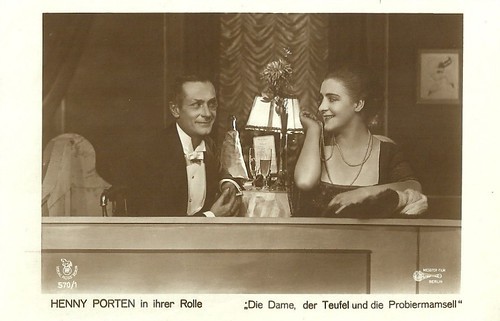
German postcard in the Film Sterne series by Rotophot, no. 570/1. Photo: Messter-Film, Berlin. Henny Porten and Alfred Abel in Die Dame, der Teufel und die Probiermamsell (Rudolf Biebrach, 1918).
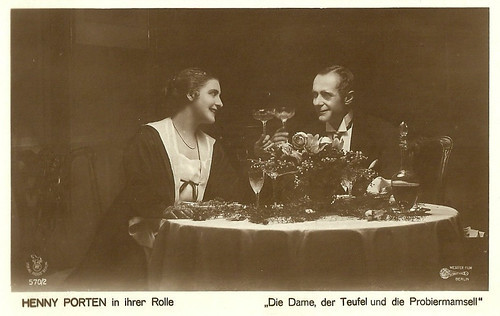
German postcard in the Film Sterne series by Rotophot, no. 570/2. Photo: Messter-Film, Berlin. Henny Porten and Alfred Abel in Die Dame, der Teufel und die Probiermamsell (Rudolf Biebrach, 1918).
The conditions of the Beelzebub
A young mannequin ( Henny Porten ) has only one dream: to finally get hold of the wonderful ermine fur, which she admires every day in the shop window of the Herpich fur house. Her dreams go so far that one day she imagines that the fine gentleman ( Alfred Abel ) who bought the good piece of clothing at the fashion show today appears to her as the devil, kidnaps her to hell and gives her a choice: if she fulfills three conditions, she gets the coat. The cheeky woman spontaneously fulfills the conditions of the Beelzebub, but her anger is all the greater when she still doesn't get the coat: the devil put her in!
At that moment she is knocked out of her restless sleep. The mannequin opens the door - and in front of her stands the owner of the fur, who had just made her life hell as a devil. This is where the turbulence really gets going, because by mistaking it, the little mannequin may play a spoiled millionaire for a week, whose wishes are all fulfilled - except for one thing: owning the ermine fur. But she will soon forget that in all the hustle and bustle anyway. Rather, she realises that she is happy with her groom Fritz (Eugen Rex) without wealth. And even without an ermine coat.
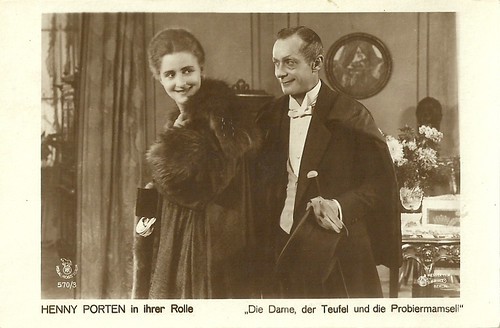
German postcard in the Film Sterne series by Rotophot, no. 570/3. Photo: Messter-Film, Berlin. Henny Porten and Alfred Abel in Die Dame, der Teufel und die Probiermamsell (Rudolf Biebrach, 1918).
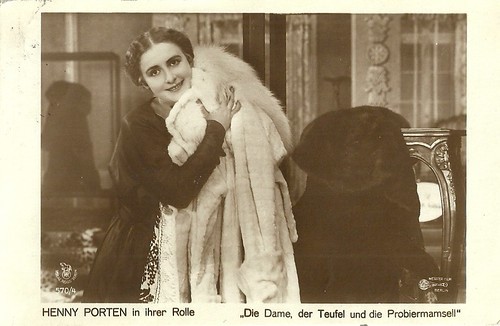
German postcard in the Film Sterne series by Rotophot, no. 570/4. Photo: Messter-Film, Berlin. Henny Porten in Die Dame, der Teufel und die Probiermamsell (Rudolf Biebrach, 1918).
Sources: Filmportal.de (German), Wikipedia (German and English), and IMDb.

German postcard in the Film Sterne series by Rotophot, no. 570/1. Photo: Messter-Film, Berlin. Henny Porten and Alfred Abel in Die Dame, der Teufel und die Probiermamsell (Rudolf Biebrach, 1918).

German postcard in the Film Sterne series by Rotophot, no. 570/2. Photo: Messter-Film, Berlin. Henny Porten and Alfred Abel in Die Dame, der Teufel und die Probiermamsell (Rudolf Biebrach, 1918).
The conditions of the Beelzebub
A young mannequin ( Henny Porten ) has only one dream: to finally get hold of the wonderful ermine fur, which she admires every day in the shop window of the Herpich fur house. Her dreams go so far that one day she imagines that the fine gentleman ( Alfred Abel ) who bought the good piece of clothing at the fashion show today appears to her as the devil, kidnaps her to hell and gives her a choice: if she fulfills three conditions, she gets the coat. The cheeky woman spontaneously fulfills the conditions of the Beelzebub, but her anger is all the greater when she still doesn't get the coat: the devil put her in!
At that moment she is knocked out of her restless sleep. The mannequin opens the door - and in front of her stands the owner of the fur, who had just made her life hell as a devil. This is where the turbulence really gets going, because by mistaking it, the little mannequin may play a spoiled millionaire for a week, whose wishes are all fulfilled - except for one thing: owning the ermine fur. But she will soon forget that in all the hustle and bustle anyway. Rather, she realises that she is happy with her groom Fritz (Eugen Rex) without wealth. And even without an ermine coat.

German postcard in the Film Sterne series by Rotophot, no. 570/3. Photo: Messter-Film, Berlin. Henny Porten and Alfred Abel in Die Dame, der Teufel und die Probiermamsell (Rudolf Biebrach, 1918).

German postcard in the Film Sterne series by Rotophot, no. 570/4. Photo: Messter-Film, Berlin. Henny Porten in Die Dame, der Teufel und die Probiermamsell (Rudolf Biebrach, 1918).
Sources: Filmportal.de (German), Wikipedia (German and English), and IMDb.
Published on May 04, 2020 22:00
May 3, 2020
Raymond Aimos
Character actor Raymond Aimos (1891–1944) or simply Aimos was one of the familiar faces of the French cinema of the 1930s and early 1940s. During this golden age of poetic realism, he was the quintessential 'Titi Parisien' (Parisian kid) in at least 105 films. His film characters generally corresponded with himself: humble, poor, colourful, cheeky but with a heart of gold.
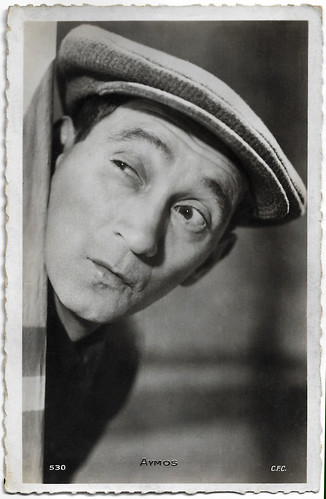
French postcard, no. 530. Photo: C.F.C.
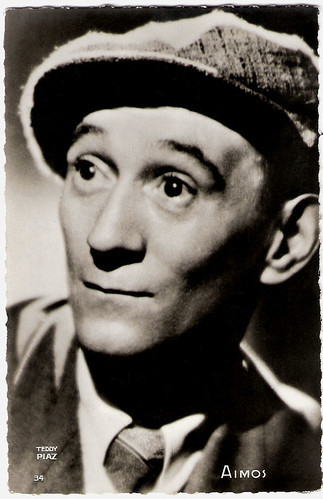
French postcard by Editions P.I., Paris, no. 34. Photo: Teddy Piaz.
Urban Legends
Raymond Aimos was born as Raymond Arthur Caudrilliers in La Fère, in the Aisne department in the North of France in 1891 (1889 (sic) according to IMDb , English Wikipedia, and other sources, who also erroneously write that his birth name is Raymond Coudurier). He was the son of a watchmaker-jeweler and was expected to work in the family business but young Raymond was uncontrollably attracted to show business.
He managed to become an opera singer under the stage name Aimos. According to urban legends, retold by different sources, he made his first film appearance as a kid either in the Lumière brothers’ L’arroseur arose/The Sprinkler Sprinkled (Louis Lumière, 1895) or in a film by another legendary film pioneer, Georges Méliès. (In the first film, the naughty boy was Benoît Duval).
However, officially Aimos made his cinema debut in the short silent Western Pendaison à Jefferson City/Hanging at Jefferson City (Jean Durand, 1910) with Joë Hamman and Gaston Modot .
He appeared in more early silent shorts, like the Onesime comedies Onésime et le nourrisson de la nourrice indigne/ Onesimus and the infant unworthy of the nurse (Jean Durand, 1912), Onésime a un duel à l'américaine/Onesime has an American-style duel (Jean Durand, 1912) and Onésime horloger/Onesime, Clockmaker (Jean Durand, 1912), all starring Ernest Bourbon aka Onésime.
A decade later, Aimos appeared in The Three Musketeers-sequel Vingt Ans après/Five Years Later (Henri Diamant-Berger, 1922), based on the novel by Alexandre Dumas père. These film parts had all been modest, but Aimos’ lucky strike would be the coming of sound.
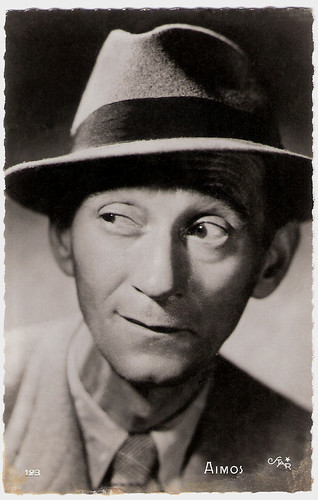
French postcard by Editions P.I., Paris, no. 123 Photo: Star.
Highlights of the Poetic realism
Aimos' physical appearance, his popular roots and mostly his gift of gab were in perfect harmony with the sound cinema of the 1930s. He was wonderful as a humble man of the people in two masterpieces by René Clair, Sous les toits de Paris/Under the Roofs of Paris (1930) starring Albert Préjean , and Quatorze juillet/July 14 (1933) with Annabella .
It lead to more work for important directors. He appeared for Raymond Bernard as a soldier in the war drama Les croix de bois/Wooden Crosses (1932) with Pierre Blanchar , and a clochard in Amants et voleurs/Lovers and Thieves (1935) with Arletty , for Sacha Guitry as another clochard in Ils étaient neuf célibataires/Nine Bachelors (1939), for Marcel Carné as Quart-Vittel, the wreck in Quai des brumes/Port of Shadows (1938), and for Jean Grémillon in Lumière d'été/Summer Light (1943) starring Madeleine Renaud .
His most memorable roles were in the films by Julien Duvivier, such as Mulot, the legionary friend of Jean Gabin in La Bandera/Escape from Yesterday (1935), and Tintin, one of the five friends who build a riverside café after winning the jackpot in the lottery in La Belle Équipe/They Were Five (1936) with Jean Gabin and Charles Vanel . He also appeared in Duvivier’s Le paquebot Tenacity/S.S. Tenacity (Julien Duvivier, 1934) with Albert Préjean , and L’homme du jour/The Man of the Hour (Julien Duvivier, 1937) starring Maurice Chevalier .
At IMDb , Guy Bellinger writes: “But even when he worked for less distinctive directors his presence was an asset for the film.” Some of these films now belong to the highlights of the Poetic realism, a French genre of the 1930s of lyrical, stylized and studio-bound films which offered a fatalistic view of life with their characters living on the margins of society, either as unemployed members of the working class or as criminals.
Raymond Aimos was a courageous man with a big heart in life. In 1940, he opened a restaurant in the Rue Montmartre in the capital, 'L'Oeuvre des Gosses d'Aimos', intended to feed the poor children of the neighbourhood. In August 1944, he decided to take part in the uprising against the Nazis which would lead to the Liberation of Paris.
He was unfortunately hit by a stray bullet in the 10th Arrondissement. The exact circumstances of his death remain unclear and undetermined. He was only 53. Aimos is buried in the cemetery of Chennevières-sur-Marne (Val-de-Marne).
Raymond Aimos was married to Madeleine Botté from 1923 till their divorce in 1938. They had no children. But he left an impressive film legacy, according to some sources he even appeared in nearly 450 films! ( IMDb only mentions 109 films).
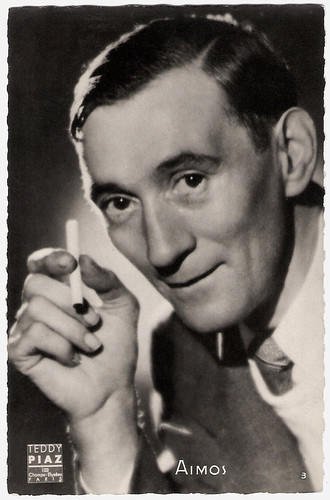
French postcard by Editions O.P., Paris, no. 3 Photo: Teddy Piaz, Paris.
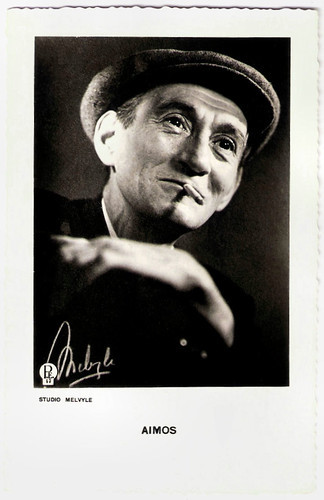
Belgian postcard by P.E. (Photo Édition, Bruxelles), no. 17. Photo: Studio Melvyle.
Sources: Simon Benattar-Bourgeay (Ciné-Artistes - French), Yvan Foucart (L'encinémathèque - French), (IMDb), Wikipedia (French and English) and .

French postcard, no. 530. Photo: C.F.C.

French postcard by Editions P.I., Paris, no. 34. Photo: Teddy Piaz.
Urban Legends
Raymond Aimos was born as Raymond Arthur Caudrilliers in La Fère, in the Aisne department in the North of France in 1891 (1889 (sic) according to IMDb , English Wikipedia, and other sources, who also erroneously write that his birth name is Raymond Coudurier). He was the son of a watchmaker-jeweler and was expected to work in the family business but young Raymond was uncontrollably attracted to show business.
He managed to become an opera singer under the stage name Aimos. According to urban legends, retold by different sources, he made his first film appearance as a kid either in the Lumière brothers’ L’arroseur arose/The Sprinkler Sprinkled (Louis Lumière, 1895) or in a film by another legendary film pioneer, Georges Méliès. (In the first film, the naughty boy was Benoît Duval).
However, officially Aimos made his cinema debut in the short silent Western Pendaison à Jefferson City/Hanging at Jefferson City (Jean Durand, 1910) with Joë Hamman and Gaston Modot .
He appeared in more early silent shorts, like the Onesime comedies Onésime et le nourrisson de la nourrice indigne/ Onesimus and the infant unworthy of the nurse (Jean Durand, 1912), Onésime a un duel à l'américaine/Onesime has an American-style duel (Jean Durand, 1912) and Onésime horloger/Onesime, Clockmaker (Jean Durand, 1912), all starring Ernest Bourbon aka Onésime.
A decade later, Aimos appeared in The Three Musketeers-sequel Vingt Ans après/Five Years Later (Henri Diamant-Berger, 1922), based on the novel by Alexandre Dumas père. These film parts had all been modest, but Aimos’ lucky strike would be the coming of sound.

French postcard by Editions P.I., Paris, no. 123 Photo: Star.
Highlights of the Poetic realism
Aimos' physical appearance, his popular roots and mostly his gift of gab were in perfect harmony with the sound cinema of the 1930s. He was wonderful as a humble man of the people in two masterpieces by René Clair, Sous les toits de Paris/Under the Roofs of Paris (1930) starring Albert Préjean , and Quatorze juillet/July 14 (1933) with Annabella .
It lead to more work for important directors. He appeared for Raymond Bernard as a soldier in the war drama Les croix de bois/Wooden Crosses (1932) with Pierre Blanchar , and a clochard in Amants et voleurs/Lovers and Thieves (1935) with Arletty , for Sacha Guitry as another clochard in Ils étaient neuf célibataires/Nine Bachelors (1939), for Marcel Carné as Quart-Vittel, the wreck in Quai des brumes/Port of Shadows (1938), and for Jean Grémillon in Lumière d'été/Summer Light (1943) starring Madeleine Renaud .
His most memorable roles were in the films by Julien Duvivier, such as Mulot, the legionary friend of Jean Gabin in La Bandera/Escape from Yesterday (1935), and Tintin, one of the five friends who build a riverside café after winning the jackpot in the lottery in La Belle Équipe/They Were Five (1936) with Jean Gabin and Charles Vanel . He also appeared in Duvivier’s Le paquebot Tenacity/S.S. Tenacity (Julien Duvivier, 1934) with Albert Préjean , and L’homme du jour/The Man of the Hour (Julien Duvivier, 1937) starring Maurice Chevalier .
At IMDb , Guy Bellinger writes: “But even when he worked for less distinctive directors his presence was an asset for the film.” Some of these films now belong to the highlights of the Poetic realism, a French genre of the 1930s of lyrical, stylized and studio-bound films which offered a fatalistic view of life with their characters living on the margins of society, either as unemployed members of the working class or as criminals.
Raymond Aimos was a courageous man with a big heart in life. In 1940, he opened a restaurant in the Rue Montmartre in the capital, 'L'Oeuvre des Gosses d'Aimos', intended to feed the poor children of the neighbourhood. In August 1944, he decided to take part in the uprising against the Nazis which would lead to the Liberation of Paris.
He was unfortunately hit by a stray bullet in the 10th Arrondissement. The exact circumstances of his death remain unclear and undetermined. He was only 53. Aimos is buried in the cemetery of Chennevières-sur-Marne (Val-de-Marne).
Raymond Aimos was married to Madeleine Botté from 1923 till their divorce in 1938. They had no children. But he left an impressive film legacy, according to some sources he even appeared in nearly 450 films! ( IMDb only mentions 109 films).

French postcard by Editions O.P., Paris, no. 3 Photo: Teddy Piaz, Paris.

Belgian postcard by P.E. (Photo Édition, Bruxelles), no. 17. Photo: Studio Melvyle.
Sources: Simon Benattar-Bourgeay (Ciné-Artistes - French), Yvan Foucart (L'encinémathèque - French), (IMDb), Wikipedia (French and English) and .
Published on May 03, 2020 22:00
May 2, 2020
Dick Powell
American singer and actor Dick Powell (1904-1963) was also a film producer, film director, and studio head. Though he came to stardom as a juvenile lead in the Warner backstage musicals, Powell showed versatility and successfully transformed into a hardboiled leading man in Film Noirs. He was the first actor to portray the private detective Philip Marlowe on screen.
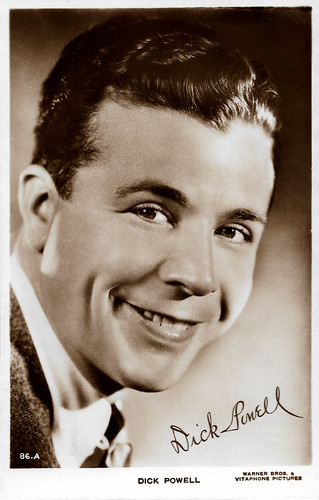
British Real Photograph postcard, no. 86a. Photo: Warner Bros and Vitaphone Pictures.
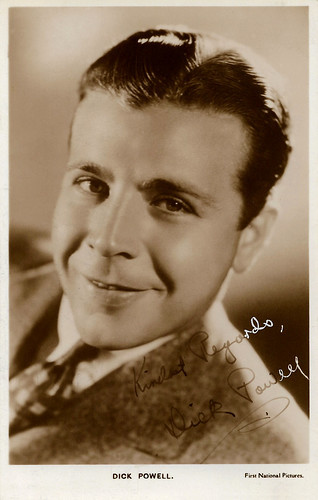
British postcard. Photo: First National Pictures.
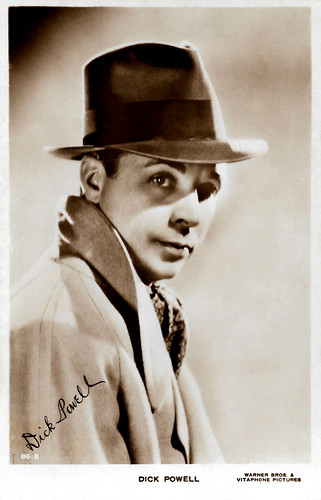
British Real Photograph postcard, no. 86.B. Photo: Warner Bros and Vitaphone Pictures. Dick Powell as Philip Marlowe in Murder, My Sweet (Edward Dmytryk, 1944).
A boyish crooner
Richard Ewing Powell was born in Mountain View, the seat of Stone County in northern Arkansas. Powell was the son of Ewing Powell and Sallie Rowena Thompson. He was one of three brothers. His brothers were Luther and Howard Powell, who ended up as vice president of the Illinois Central Railroad.
The family moved to Little Rock in 1914, where Powell sang in church choirs and with local orchestras and started his own band. Powell attended the former Little Rock College before he started his entertainment career as a singer and banjo player with the Royal Peacock Band. He then got a gig with the Charlie Davis band and toured with them throughout the mid-west, appearing at dance halls and picture theatres.
In 1925, he married Mildred Maund, a model, but she found being married to an entertainer, not to her liking. After a final trip to Cuba together, Mildred moved to Hemphill, Texas, and the couple divorced in 1932.
He recorded a number of records with Davis and on his own, for the Vocalion label in the late 1920s. Powell moved to Pittsburgh, where he found great local success as the Master of Ceremonies at the Enright Theater and the Stanley Theater. In April 1930, Warner Bros. bought Brunswick Records, which at that time owned Vocalion. Warner Bros. was sufficiently impressed by Dick Powell's singing and stage presence to offer him a film contract in 1932.
He made his film debut as a singing bandleader in Blessed Event (Roy Del Ruth, 1932) with Lee Tracy and Mary Brian. He was borrowed by Fox to support Will Rogers in Too Busy to Work (John G. Blystone, 1932). He was a boyish crooner, the sort of role he specialised in for the next few years.
Back at Warners, he supported George Arliss in The King's Vacation (John G. Adolfi, 1933). Then he was the love interest for Ruby Keeler in 42nd Street (Lloyd Bacon, 1933), which was a massive hit. Warner let him repeat the role in Gold Diggers of 1933 (Mervyn LeRoy, 1933), which was another big success.
Looking rather younger than his actual years, Powell soon found himself typecast as clean-cut singing juveniles. Another hit was Footlight Parade (Lloyd Bacon, 1933), with Keeler, Joan Blondell , and James Cagney. Powell was upped to star for College Coach (William A. Wellman, 1933), then went back to more ensemble pieces including Convention City (Archie Mayo, 1933), and Dames (Ray Enright, Busby Berkeley, 1934).
He was top-billed in Gold Diggers of 1935 (Busby Berkeley, 1935), with Joan Blondell . He supported Marion Davies in Page Miss Glory (Mervyn LeRoy, 1935), made for Cosmopolitan Pictures, a production company financed by Davies' lover William Randolph Hearst who released through Warners. Warners gave Dick Powell a change of pace, casting him as Lysander in A Midsummer Night's Dream (William Dieterle, Max Reinhardt, 1935).
He did two films with his then-wife, Joan Blondell , Stage Struck (Busby Berkeley, 1936) and Gold Diggers of 1937 (Lloyd Bacon, 1937). Then 20th Century Fox borrowed him for On the Avenue (Roy Del Ruth, 1937) with Madeleine Carroll . Back at Warners, he appeared in Hard to Get (Ray Enright, 1938) with Olivia de Havilland , and Naughty but Nice (Ray Enright, 1939), starring Ann Sheridan. Fed up with the repetitive nature of his roles, Powell left Warner Bros and went to work for Paramount.
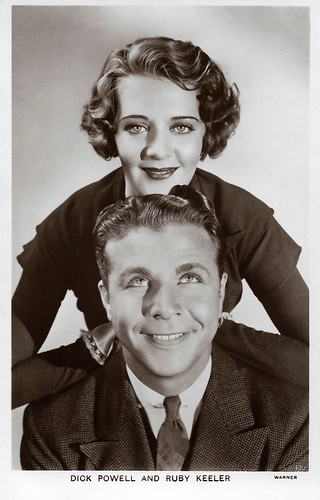
British postcard in the Film Partners Series, London, no. P 114. Photo: Warner. Dick Powell and Ruby Keeler in 42nd Street (Lloyd Bacon, 1933).
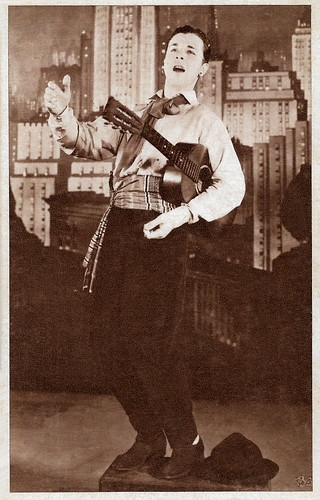
Romanian postcard. Photo: Warner Bros. Dick Powell in Broadway Gondolier (Lloyd Bacon, 1935).
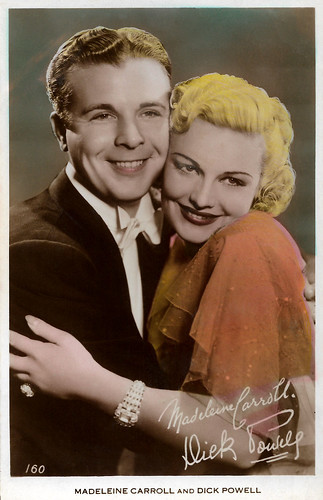
British Art Photo postcard, no. 160. Photo: Warner Bros. Dick Powell and Madeleine Carroll in On the Avenue (Roy Del Ruth, 1937).
Rugged crime fighter
At Paramount, Dick Powell and Joan Blondell were in another musical, I Want a Divorce (Ralph Murphy, 1940). Then Powell got a chance to appear in a non-musical and starred opposite Ellen Drew in the sparkling Preston Sturges comedy Christmas in July (1940). I.S. Mowis at IMDb cites Powell saying: "I knew I wasn't the greatest singer in the world and I saw no reason why an actor should restrict himself to any one particular phase of the business".
Universal borrowed him to support Abbott and Costello in In the Navy (Arthur Lubin, 1941), one of the most popular films of 1941. He was in a fantasy comedy directed by René Clair, It Happened Tomorrow (1944) then went over to MGM to appear opposite Lucille Ball in Meet the People (Charles Reisner, 1944), which was a box office flop.
During this period, Powell starred in the musical program 'Campana Serenade', which was broadcast on NBC radio (1942–1943) and CBS radio (1943–1944). I.S. Mowis at IMDb : "Few actors ever managed a complete image transition as thoroughly as did Dick Powell: in his case, from the boyish, wavy-haired crooner in musicals to rugged crime fighters in films noir."
By 1944, Powell felt he was too old to play romantic leading men anymore. Still dissatisfied with lightweight roles, Powell lobbied hard to get the lead in Double Indemnity. He lost out to Fred MacMurray, another Hollywood nice guy. MacMurray's success, however, fueled Powell's resolve to pursue projects with greater range.
Instead, he was slotted into more of the same fare, refused to comply and was suspended. Powell tried his luck at RKO and at last, managed to secure a lucrative role: that of hard-boiled private eye Philip Marlowe in Raymond Chandler's Murder, My Sweet (Edward Dmytryk, 1944). He was the first actor to play Marlowe – by name – in motion pictures. Hollywood had previously adapted some Marlowe novels, but with the lead character changed. Later, Powell was the first actor to play Marlowe on radio, in 1944 and 1945, and on television, in an episode of Climax! (1954).
Murder My Sweet was a big hit. Bosley Crowther in the New York Times : " ...and while he may lack the steely coldness and cynicism of a Humphrey Bogart, Mr. Powell need not offer any apologies. He has definitely stepped out of the song-and-dance, pretty-boy league with this performance".
Powell had successfully reinvented himself as a dramatic actor. His career changed dramatically: he was cast in a series of Films Noirs. On the radio, Powell played detective Richard Rogue in the series 'Rogue's Gallery' beginning in 1945. On-screen, Dmytryk, and Powell re-teamed to make the film Cornered (Edward Dmytryk, 1945), a gripping, post-World War II thriller that helped define the Film Noir style.
For Columbia, he played a detective in Johnny O'Clock (Robert Rossen, 1947) and made To the Ends of the Earth (Robert Stevenson, 1948) with Signe Hasso. In 1948, he stepped out of the brutish type when he starred in Pitfall (André De Toth, 1948), a Film Noir in which a bored insurance company worker falls for an innocent but dangerous woman, played by Lizabeth Scott.
He broadened his range appearing in a Western, Station West (Sidney Lanfield, 1948), and a French Foreign Legion tale, Rogues' Regiment (Robert Florey, 1949) with Marta Toren . He was a Mountie in Mrs. Mike (Louis King, 1950). From 1949 to 1953, Powell played the lead role in the NBC radio theater production 'Richard Diamond, Private Detective'. His character in the 30-minute weekly was a likable private detective with a quick wit. Many episodes were written by Blake Edwards and many ended with Detective Diamond having an excuse to sing a little song to his date.
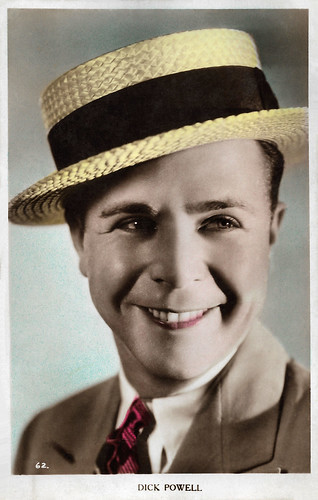
British postcard by Art Photo, no. 62.
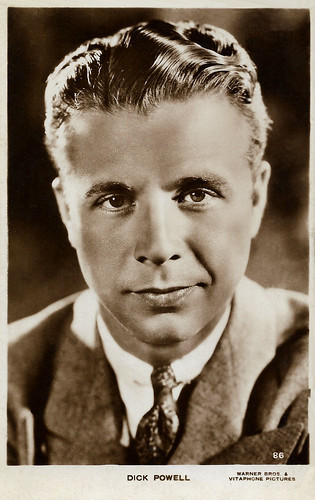
British real Photograph postcard, no. 86. Photo: Warner Bros and Vitaphone Pictures.
The Dick Powell Show
Dick Powell took a break from tough-guy roles in The Reformer and the Redhead (Melvin Frank, Norman Panama, 1950), opposite his new wife June Allyson. Then it was back to tougher films: Cry Danger (Robert Parrish, 1951), as an ex-con; and The Tall Target (Anthony Mann, 1951), as a detective who tries to prevent the assassination of Abraham Lincoln. He returned to comedy with You Never Can Tell (Lou Breslow, 1951).
He had a good role as best-selling novelist James Lee Bartlow in the popular melodrama, The Bad and the Beautiful (Vincente Minnelli, 1952). His final film performance was in a romantic comedy Susan Slept Here (1954) for director Frank Tashlin. Even when he appeared in lighter fare such as Susan Slept Here (Frank Tashlin, 1954), he never sang in his later roles. It was his final onscreen appearance in a feature film and included a dance number with co-star Debbie Reynolds.
By this stage, Powell had turned director. His feature debut was Split Second (1953) with Stephen McNally and Alexis Smith. He followed it with The Conqueror (1956), coproduced by Howard Hughes starring John Wayne as Genghis Khan. The exterior scenes were filmed in St. George, Utah, downwind of U.S. above-ground atomic tests. The cast and crew totaled 220, and of that number, 91 had developed some form of cancer by 1981, and 46 had died of cancer by then, including Powell and Wayne.
He directed Allyson opposite Jack Lemmon in You Can't Run Away from It (1956). Powell then made two war films at Fox with Robert Mitchum , The Enemy Below (1957) and The Hunters (1958). In the 1950s, Powell was one of the founders of Four Star Television, along with Charles Boyer, David Niven, and Ida Lupino. He appeared in and supervised several shows for that company. Powell played the role of Willie Dante in episodes of Four Star Playhouse, and guest-starred in numerous Four Star programs.
Shortly before his death, Powell sang on camera for the final time in a guest-star appearance on Four Star's Ensign O'Toole, singing 'The Song of the Marines', which he first sang in his film The Singing Marine (Ray Enright, 1937). He hosted and occasionally starred in his Dick Powell's Zane Grey Theater on CBS from 1956–1961, and his final anthology series, The Dick Powell Show on NBC from 1961 through 1963; after his death, the series continued through the end of its second season as The Dick Powell Theater, with guest hosts.
He married three times: Mildred Evelyn Maund (1925-1932), Joan Blondell (1936-1944) and June Allyson (1945, until his death in 1963). He adopted Joan Blondell's son from a previous marriage, Norman Powell, who later became a television producer; the couple also had one child together, Ellen Powell. He had two children with Allyson, Pamela (adopted) and Richard 'Dick' Powell, Jr.
Powell's ranch-style house was used for exterior filming on the ABC TV series, Hart to Hart. Powell was a friend of Hart to Hart actor Robert Wagner and producer Aaron Spelling.
In 1962, Powell acknowledged rumours that he was undergoing treatment for cancer. The disease was originally diagnosed as an allergy, with Powell first experiencing symptoms while traveling East to promote his program. Upon his return to California, Powell's personal physician conducted tests and found malignant tumors on his neck and chest.
Dick Powell died at the age of 58 in 1963. His body was cremated and his remains were interred in the Columbarium of Honor at Forest Lawn Memorial Park in Glendale, California. In the film The Day of the Locust (John Schlesinger, 1975), Powell was portrayed by his son Dick Powell Jr.
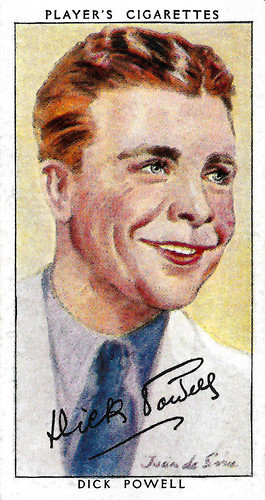
Small, British collectors card in the Film Stars series by Player's Cigarettes, no. 21. Illustration: Juan de Sorie (?) / Warner - First National.
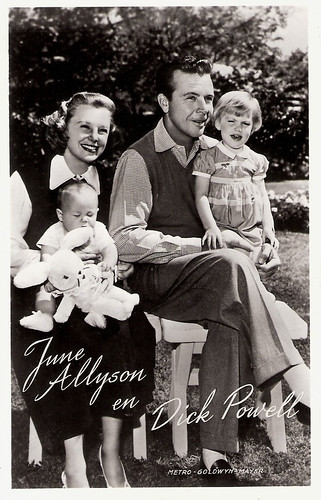
Dutch postcard by Takken / 't Sticht, no. 757. Photo: Metro-Goldwyn-Mayer. With June Allyson and their children Pamela and Dick Jr.
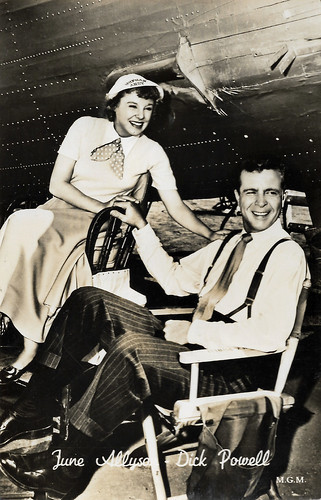
Vintage postcard. Photo: M.G.M.
Sources: (IMDb), Wikipedia and .

British Real Photograph postcard, no. 86a. Photo: Warner Bros and Vitaphone Pictures.

British postcard. Photo: First National Pictures.

British Real Photograph postcard, no. 86.B. Photo: Warner Bros and Vitaphone Pictures. Dick Powell as Philip Marlowe in Murder, My Sweet (Edward Dmytryk, 1944).
A boyish crooner
Richard Ewing Powell was born in Mountain View, the seat of Stone County in northern Arkansas. Powell was the son of Ewing Powell and Sallie Rowena Thompson. He was one of three brothers. His brothers were Luther and Howard Powell, who ended up as vice president of the Illinois Central Railroad.
The family moved to Little Rock in 1914, where Powell sang in church choirs and with local orchestras and started his own band. Powell attended the former Little Rock College before he started his entertainment career as a singer and banjo player with the Royal Peacock Band. He then got a gig with the Charlie Davis band and toured with them throughout the mid-west, appearing at dance halls and picture theatres.
In 1925, he married Mildred Maund, a model, but she found being married to an entertainer, not to her liking. After a final trip to Cuba together, Mildred moved to Hemphill, Texas, and the couple divorced in 1932.
He recorded a number of records with Davis and on his own, for the Vocalion label in the late 1920s. Powell moved to Pittsburgh, where he found great local success as the Master of Ceremonies at the Enright Theater and the Stanley Theater. In April 1930, Warner Bros. bought Brunswick Records, which at that time owned Vocalion. Warner Bros. was sufficiently impressed by Dick Powell's singing and stage presence to offer him a film contract in 1932.
He made his film debut as a singing bandleader in Blessed Event (Roy Del Ruth, 1932) with Lee Tracy and Mary Brian. He was borrowed by Fox to support Will Rogers in Too Busy to Work (John G. Blystone, 1932). He was a boyish crooner, the sort of role he specialised in for the next few years.
Back at Warners, he supported George Arliss in The King's Vacation (John G. Adolfi, 1933). Then he was the love interest for Ruby Keeler in 42nd Street (Lloyd Bacon, 1933), which was a massive hit. Warner let him repeat the role in Gold Diggers of 1933 (Mervyn LeRoy, 1933), which was another big success.
Looking rather younger than his actual years, Powell soon found himself typecast as clean-cut singing juveniles. Another hit was Footlight Parade (Lloyd Bacon, 1933), with Keeler, Joan Blondell , and James Cagney. Powell was upped to star for College Coach (William A. Wellman, 1933), then went back to more ensemble pieces including Convention City (Archie Mayo, 1933), and Dames (Ray Enright, Busby Berkeley, 1934).
He was top-billed in Gold Diggers of 1935 (Busby Berkeley, 1935), with Joan Blondell . He supported Marion Davies in Page Miss Glory (Mervyn LeRoy, 1935), made for Cosmopolitan Pictures, a production company financed by Davies' lover William Randolph Hearst who released through Warners. Warners gave Dick Powell a change of pace, casting him as Lysander in A Midsummer Night's Dream (William Dieterle, Max Reinhardt, 1935).
He did two films with his then-wife, Joan Blondell , Stage Struck (Busby Berkeley, 1936) and Gold Diggers of 1937 (Lloyd Bacon, 1937). Then 20th Century Fox borrowed him for On the Avenue (Roy Del Ruth, 1937) with Madeleine Carroll . Back at Warners, he appeared in Hard to Get (Ray Enright, 1938) with Olivia de Havilland , and Naughty but Nice (Ray Enright, 1939), starring Ann Sheridan. Fed up with the repetitive nature of his roles, Powell left Warner Bros and went to work for Paramount.

British postcard in the Film Partners Series, London, no. P 114. Photo: Warner. Dick Powell and Ruby Keeler in 42nd Street (Lloyd Bacon, 1933).

Romanian postcard. Photo: Warner Bros. Dick Powell in Broadway Gondolier (Lloyd Bacon, 1935).

British Art Photo postcard, no. 160. Photo: Warner Bros. Dick Powell and Madeleine Carroll in On the Avenue (Roy Del Ruth, 1937).
Rugged crime fighter
At Paramount, Dick Powell and Joan Blondell were in another musical, I Want a Divorce (Ralph Murphy, 1940). Then Powell got a chance to appear in a non-musical and starred opposite Ellen Drew in the sparkling Preston Sturges comedy Christmas in July (1940). I.S. Mowis at IMDb cites Powell saying: "I knew I wasn't the greatest singer in the world and I saw no reason why an actor should restrict himself to any one particular phase of the business".
Universal borrowed him to support Abbott and Costello in In the Navy (Arthur Lubin, 1941), one of the most popular films of 1941. He was in a fantasy comedy directed by René Clair, It Happened Tomorrow (1944) then went over to MGM to appear opposite Lucille Ball in Meet the People (Charles Reisner, 1944), which was a box office flop.
During this period, Powell starred in the musical program 'Campana Serenade', which was broadcast on NBC radio (1942–1943) and CBS radio (1943–1944). I.S. Mowis at IMDb : "Few actors ever managed a complete image transition as thoroughly as did Dick Powell: in his case, from the boyish, wavy-haired crooner in musicals to rugged crime fighters in films noir."
By 1944, Powell felt he was too old to play romantic leading men anymore. Still dissatisfied with lightweight roles, Powell lobbied hard to get the lead in Double Indemnity. He lost out to Fred MacMurray, another Hollywood nice guy. MacMurray's success, however, fueled Powell's resolve to pursue projects with greater range.
Instead, he was slotted into more of the same fare, refused to comply and was suspended. Powell tried his luck at RKO and at last, managed to secure a lucrative role: that of hard-boiled private eye Philip Marlowe in Raymond Chandler's Murder, My Sweet (Edward Dmytryk, 1944). He was the first actor to play Marlowe – by name – in motion pictures. Hollywood had previously adapted some Marlowe novels, but with the lead character changed. Later, Powell was the first actor to play Marlowe on radio, in 1944 and 1945, and on television, in an episode of Climax! (1954).
Murder My Sweet was a big hit. Bosley Crowther in the New York Times : " ...and while he may lack the steely coldness and cynicism of a Humphrey Bogart, Mr. Powell need not offer any apologies. He has definitely stepped out of the song-and-dance, pretty-boy league with this performance".
Powell had successfully reinvented himself as a dramatic actor. His career changed dramatically: he was cast in a series of Films Noirs. On the radio, Powell played detective Richard Rogue in the series 'Rogue's Gallery' beginning in 1945. On-screen, Dmytryk, and Powell re-teamed to make the film Cornered (Edward Dmytryk, 1945), a gripping, post-World War II thriller that helped define the Film Noir style.
For Columbia, he played a detective in Johnny O'Clock (Robert Rossen, 1947) and made To the Ends of the Earth (Robert Stevenson, 1948) with Signe Hasso. In 1948, he stepped out of the brutish type when he starred in Pitfall (André De Toth, 1948), a Film Noir in which a bored insurance company worker falls for an innocent but dangerous woman, played by Lizabeth Scott.
He broadened his range appearing in a Western, Station West (Sidney Lanfield, 1948), and a French Foreign Legion tale, Rogues' Regiment (Robert Florey, 1949) with Marta Toren . He was a Mountie in Mrs. Mike (Louis King, 1950). From 1949 to 1953, Powell played the lead role in the NBC radio theater production 'Richard Diamond, Private Detective'. His character in the 30-minute weekly was a likable private detective with a quick wit. Many episodes were written by Blake Edwards and many ended with Detective Diamond having an excuse to sing a little song to his date.

British postcard by Art Photo, no. 62.

British real Photograph postcard, no. 86. Photo: Warner Bros and Vitaphone Pictures.
The Dick Powell Show
Dick Powell took a break from tough-guy roles in The Reformer and the Redhead (Melvin Frank, Norman Panama, 1950), opposite his new wife June Allyson. Then it was back to tougher films: Cry Danger (Robert Parrish, 1951), as an ex-con; and The Tall Target (Anthony Mann, 1951), as a detective who tries to prevent the assassination of Abraham Lincoln. He returned to comedy with You Never Can Tell (Lou Breslow, 1951).
He had a good role as best-selling novelist James Lee Bartlow in the popular melodrama, The Bad and the Beautiful (Vincente Minnelli, 1952). His final film performance was in a romantic comedy Susan Slept Here (1954) for director Frank Tashlin. Even when he appeared in lighter fare such as Susan Slept Here (Frank Tashlin, 1954), he never sang in his later roles. It was his final onscreen appearance in a feature film and included a dance number with co-star Debbie Reynolds.
By this stage, Powell had turned director. His feature debut was Split Second (1953) with Stephen McNally and Alexis Smith. He followed it with The Conqueror (1956), coproduced by Howard Hughes starring John Wayne as Genghis Khan. The exterior scenes were filmed in St. George, Utah, downwind of U.S. above-ground atomic tests. The cast and crew totaled 220, and of that number, 91 had developed some form of cancer by 1981, and 46 had died of cancer by then, including Powell and Wayne.
He directed Allyson opposite Jack Lemmon in You Can't Run Away from It (1956). Powell then made two war films at Fox with Robert Mitchum , The Enemy Below (1957) and The Hunters (1958). In the 1950s, Powell was one of the founders of Four Star Television, along with Charles Boyer, David Niven, and Ida Lupino. He appeared in and supervised several shows for that company. Powell played the role of Willie Dante in episodes of Four Star Playhouse, and guest-starred in numerous Four Star programs.
Shortly before his death, Powell sang on camera for the final time in a guest-star appearance on Four Star's Ensign O'Toole, singing 'The Song of the Marines', which he first sang in his film The Singing Marine (Ray Enright, 1937). He hosted and occasionally starred in his Dick Powell's Zane Grey Theater on CBS from 1956–1961, and his final anthology series, The Dick Powell Show on NBC from 1961 through 1963; after his death, the series continued through the end of its second season as The Dick Powell Theater, with guest hosts.
He married three times: Mildred Evelyn Maund (1925-1932), Joan Blondell (1936-1944) and June Allyson (1945, until his death in 1963). He adopted Joan Blondell's son from a previous marriage, Norman Powell, who later became a television producer; the couple also had one child together, Ellen Powell. He had two children with Allyson, Pamela (adopted) and Richard 'Dick' Powell, Jr.
Powell's ranch-style house was used for exterior filming on the ABC TV series, Hart to Hart. Powell was a friend of Hart to Hart actor Robert Wagner and producer Aaron Spelling.
In 1962, Powell acknowledged rumours that he was undergoing treatment for cancer. The disease was originally diagnosed as an allergy, with Powell first experiencing symptoms while traveling East to promote his program. Upon his return to California, Powell's personal physician conducted tests and found malignant tumors on his neck and chest.
Dick Powell died at the age of 58 in 1963. His body was cremated and his remains were interred in the Columbarium of Honor at Forest Lawn Memorial Park in Glendale, California. In the film The Day of the Locust (John Schlesinger, 1975), Powell was portrayed by his son Dick Powell Jr.

Small, British collectors card in the Film Stars series by Player's Cigarettes, no. 21. Illustration: Juan de Sorie (?) / Warner - First National.

Dutch postcard by Takken / 't Sticht, no. 757. Photo: Metro-Goldwyn-Mayer. With June Allyson and their children Pamela and Dick Jr.

Vintage postcard. Photo: M.G.M.
Sources: (IMDb), Wikipedia and .
Published on May 02, 2020 22:00
May 1, 2020
Vedettes of the Comédie-Française
The French publisher FA (F.A. Christensen) presented in the 1910s a postcard series with the stars of the Comédie-Française. The Comédie-Française is one of the few state theatres in France. Founded in 1680, it is the oldest active theatre company in the world. The membership of the theatrical troupe is divided into 'Sociétaires' and 'Pensionnaires'. The former are regular members of the organisation and as such receive a pension after 20 years of service, while the latter are paid actors who may, after a certain length of service, become 'Sociétaires'. The names of nearly all the great actors and dramatists of France have, at some time in their career, been associated with that of the Comédie-Française.
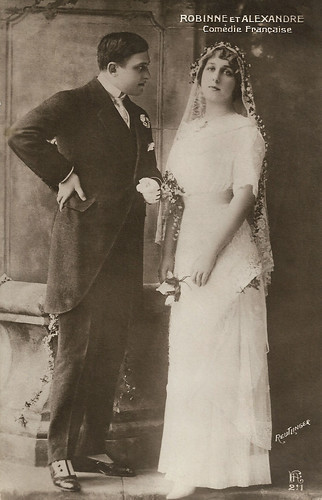
French postcard by FA, no. 2:1. Photo: Reutlinger. Caption: Robinne et Alexandre, Comédie Française.
Comédie Française actress Gabrielle Robinne (1886-1980) or Robinne was one of the first French film stars. The peak of her film career was in the 1910s when she starred in mundane and romantic dramas by Pathé. With her blond hair, passionate eyes and elegant posture, she was the perfect ‘femme du monde’. Robinne entered the Comédie-Française in 1907. She became a Societaire in 1924 and stayed there until 1938. In addition to her beauty, her versatility made her one of the most active and popular actresses on the French stage.
René Alexandre (1885-1946) or Alexandre was a French actor of the Comédie-Française. Between 1909 and 1940, he acted in some 53 films, mainly shorts by Pathé but also André Antoine’s rural drama La Terre (1921). In 1908, he entered the Comédie-Française, where he was a Sociétaire between 1920 and 1944 and became Sociétaire Honoraire in 1945. His repertory included the classics of Racine, Molière, Shakespeare and Victor Hugo, but also more modern authors such as Henri Lavedan, Paul Feerier, and Henri Marx.
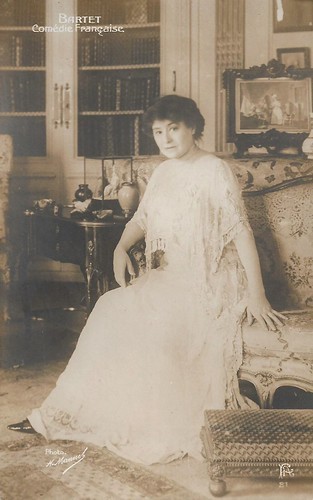
French postcard by FA, no. 21. Photo: Henri Manuel. Caption: Julia Bartet, Comédie Française.
Julia Bartet (1854-1941) was a member (1879) and sociétaire (1880) of the Comédie Française, where she was one of the big stars of her time. She retired in 1919. She played in three Film d'Art films: Le Retour d'Ulysse (1908), Rival de son père (1910), and Louis XI (1910).
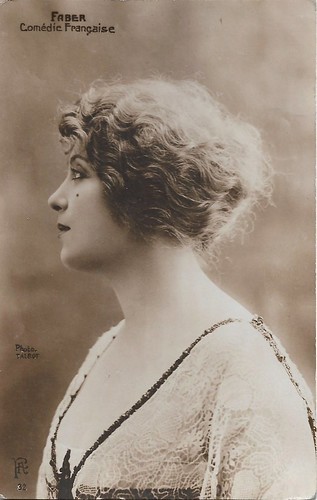
French postcard by FA, no. 32. Photo: Talbot. Caption: Faber, Comédie Française.
Jane Faber (1880-1968) was a Belgian actress, who was active in French cinema of the 1910s and is best known for her role as Princess Sonia Danidoff in the crime serial Fantomas (Louis Feuillade, 1913-1914). She was also a notable actress of the Comédie-Française, from 1910 (then becoming the 268th resident of the institution) to 1951. Among the many plays she performed at the Comédie-Française were Jules Renard's 'Poil de carrote' (1912), with Léon Bernard and Marie Leconte, Molière's and Jean-Baptiste Lully's comedy-ballet 'L'Amour médecin' (1920), with Georges Berr, 'La Dispute' (1938) by Marivaux with Jean Martinelli, 'La Reine morte' (1942) by Henry de Montherlant, with Jean-Louis Barrault , as well as 'Tartuffe ou l'imposteur' (1949) by Molière, with Jean Yonnel.
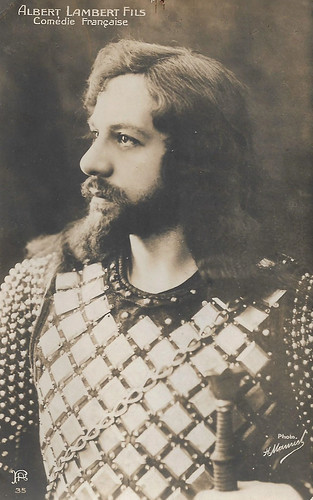
French postcard by FA, no. 35. Photo: Henri Manuel. Albert Lambert Fils de la Comédie Française.
Albert Lambert (1865-1941), a.k.a. Albert Lambert fils, was a French stage and screen actor, who was for a long time part of the Comédie-Française, but also played in several early French Film d’Art films, first of all, L'Assassinat du Duc de Guise (André Calmettes, Charles Le Bargy, 1908).
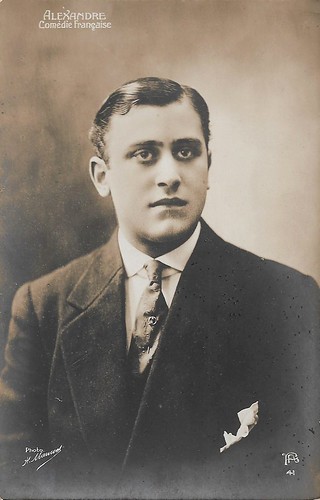
French postcard by FA, no. 41. Photo: Henri Manuel, Paris. Caption: (René) Alexandre , Comédie Française.
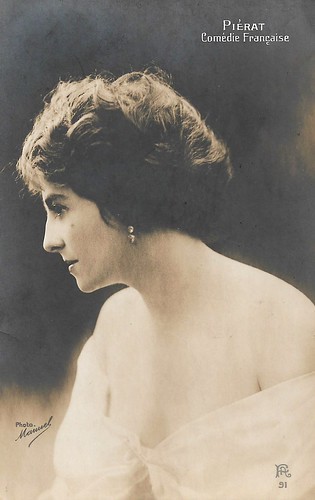
French postcard by FA, no. 51. Photo (Henri) Manuel. Caption: Pièrat, Comédie Française.
Marie-Thérèse Piérat (1883-1934), whose real name was Marie Panot, was a member of a theatre family. In 1900 she started drama school at the Paris Conservatoire (for which she swapped her birth certificate with a younger, stillborn girl) and graduated in 1901, starting her career at the Odéon theatre. She became a member (1902), Sociétaire (1905) and Doyenne of the Comédie-Française, where she mingled the classic repertory with more modern plays by Bataille, Kistemaeckers, Ibsen and Bernstein. She starred in only one film, the French silent film Pour régner (André Luguet, 1926), for which she wrote the script herself. Her early death in 1934 because of angina pectoris (she was only 50) created a stir in the international press.
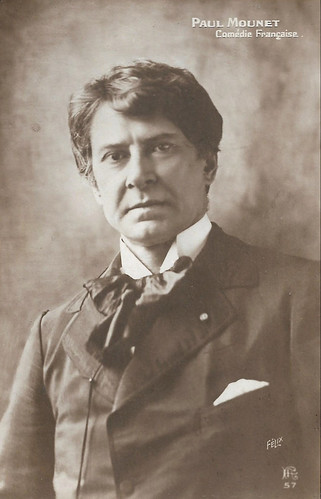
French postcard by FA, no. 57. Photo: Félix. Caption: Paul Mounet, Comédie Française.
Paul Mounet (1847–1922), born Jean-Paul Mounet, was a French actor of the Comédie Française, who also acted in various film d'art films around 1910. He was the younger brother of actor Jean Mounet-Sully.
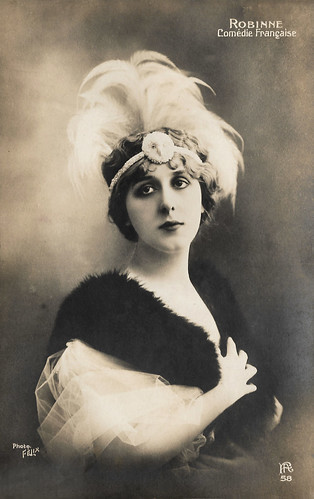
French postcard by FA, no. 58. Photo: Félix, Paris. Caption: (Gabrielle) Robinne , Comédie Française.
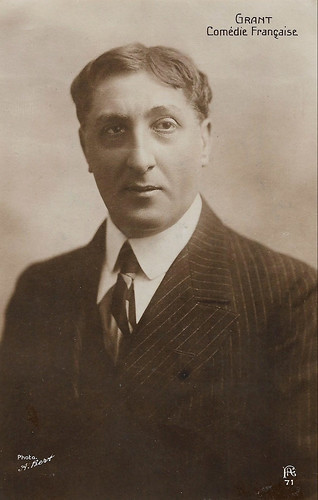
French postcard by FA, no. 71. Photo: A. Bert. Caption: Grant (sic), Comédie Française. Georges Grand's last name is misspelled.
Valentin Pierre Louis MacLeod, better known as Georges Grand (1864-1921), was a French stage and screen actor, who was first an acclaimed actor with André Antoine before becoming a reputed actor of the Comédie Française. He also acted in 11 modern and historical dramas by Pathé Frères. In 1906, he entered the Comédie-Française. Here he was Sociétaire between 1908 and 1921 and mostly played in modern repertory by Paul Hervieu, Eugène Brieux, Henry Bataille, Henry Kistemaeckers, etc.
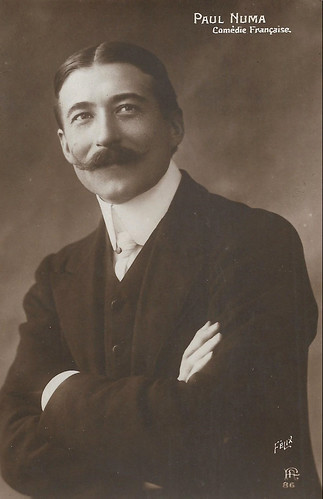
French postcard by FA, no. 86. Photo Félix. Caption: Paul Numa, Comédie Française.
Paul Jules Numa Haëring named Paul Numa (1865-1953) was a French stage and screen actor. He was a Pensionnaire at the Comédie Française, but unclear is when this started. He remained attached to it for decades, and for sure even in the years 1927-1932 he was still Pensionnaire, but he never became one of the Sociétaires.
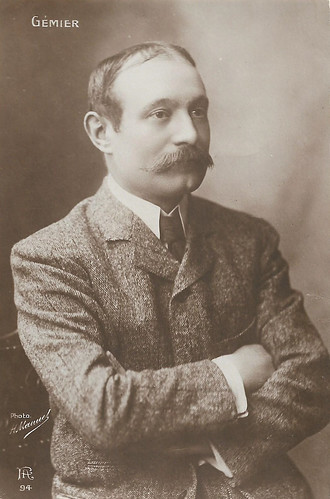
French postcard by FA, no. 94. Photo: Henri Manuel. Caption: Firmin Gémier, Comédie Française.
Firmin Gémier (1869-1933) was actor, director and theatre manager at the French stage, promotor of the Théâtre Populaire and founder of the first Théâtre National Populaire (Paris 1920). He also acted in the French silent and sound cinema of the 1910s to the 1930s.
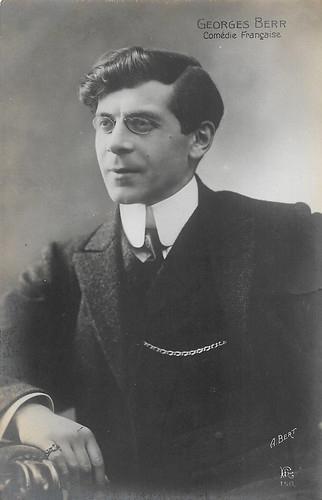
French postcard by F.A. (F.A. Christensen), no. 150. Photo: A. Bert, Paris. Caption: Georges Berr, Comédie Française.
Georges Berr (1867-1942) was a French actor and dramatist, and a member and Sociétaire of the Comédie-Française from 1886 to 1923. Under the pseudonyms Colias and Henry Bott he wrote several plays, particularly in collaboration with Louis Verneuil. While he only acted in one film, Les précieuses ridicules (1910), directed by himself, and only directed one other film, L'enfant prodigue (1909), both for Pathé Frères, Berr was a most active playwright whose plays were often adapted for the cinema, such as Le Million (René Clair, 1931), scripted by Clair and Berr himself. Berr worked on three other film scenarios, while he was the dialogue writer for four more films, including La porteuse de pain (René Sti, 1934). He was Jean-Pierre Aumont 's uncle.
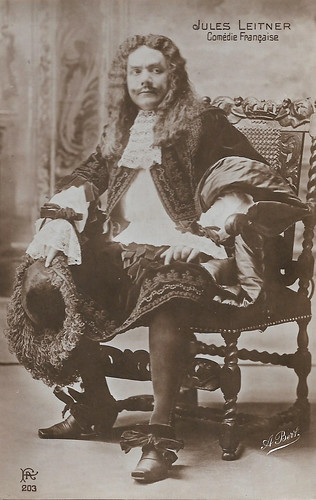
French postcard by FA, no. 203. Photo: A. Bert. Caption: Jules Leitner as Alceste in the play 'The Misanthrope' by Moliere, performed at the Comédie Française in August 1908.
Jules-Louis-Auguste Leitner (1862-1940) was a French stage actor of the Comédie Française. Leitner acted in a few films of the company Film d'Art, including Jésus de Nazareth (André Calmettes, Henri Desfontaines, 1911).
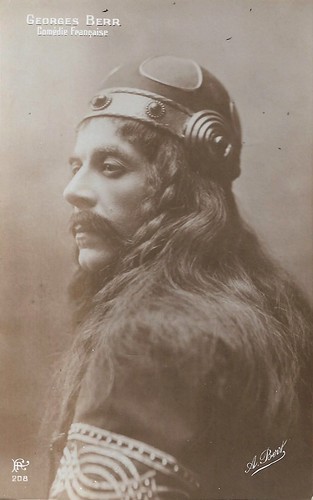
French postcard by FA, no. 208. Photo: A. Bert. Caption: Georges Berr as 'Le bon roi Dagobert' at the Comédie Française.
Georges Berr (1867-1942) in Paris, was a French actor and dramatist, a member and Sociétaire of the Comédie-Française from 1886 to 1923. Under the pseudonyms Colias and Henry Bott he wrote several plays, particularly in collaboration with Louis Verneuil. He was Jean-Pierre Aumont's uncle. While he only acted in one film, Les précieuses ridicules (1910), directed by himself, and only directed one other film, L'enfant prodigue (1909), both for Pathé Frères, Berr was a most active playwright whose plays were often adapted for the cinema, such as Le Million, filmed by René Clair, and scripted by Clair and Berr himself. Berr worked on three other film scenarios, while he was the dialogue writer for four more films, including La porteuse de pain (René Sti, 1934).
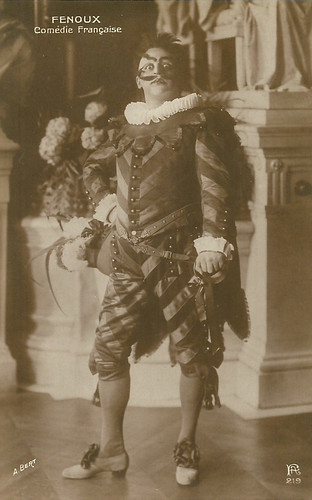
French postcard by FA, no. 219. Photo: A. Bert. Caption: Jacques Fenoux, Comédie Française.
Jacques Fenoux (1870-1930) entered the Comédie-Française in 1895, became a Sociétaire in 1906, retired in 1924, and became a Sociétaire Honoraire in 1925. As the site of the Comédie states: "Fenoux was the type of a conscientious member, able to move effortlessly from one job to another, from small to large parts. He was appointed honorary member in 1925 but continued to play until his last days. He barely disappeared two weeks after having last interpreted Bazile, from The Barber of Seville." As far is known, his only performance was in Jacques de Féraudy's film Molière, sa vie, son oeuvre (1922), in which actors of the Comédie Française can be seen rehearsing plays by Molière.
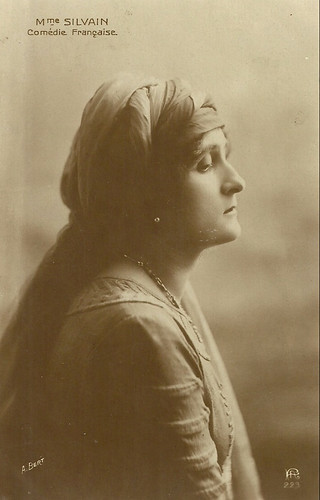
French postcard by FA, no. 223. Photo: A. Bert. Caption: Mme. Silvain, Comédie Française.
Louise Silvain (1874-1930) entered the Comédie Française in 1901, became sociétaire in 1910 and sociétaire honoraire in 1925. She was married to Eugène Silvain, aka Sylvain. She acted in the films Une scène d'Andromaque à la Comédie Française (dir. unknown, 1909) and Molière, sa vie, son oeuvre (Jacques de Féraudy, 1922).
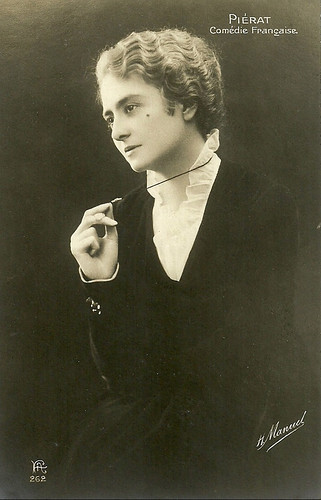
French postcard by FA, no. 262. Photo: H. Manuel. Caption: Piérat, Comédie Française.
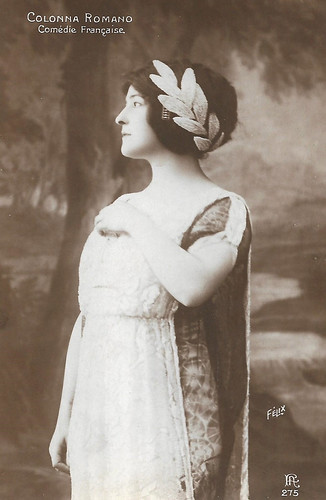
French postcard by FA, no. 275. Photo: Félix. Caption: Colonna Romano, Comédie Française.
French stage actress (Gabrielle) Colonna-Romano (1883-1981) was a pupil of Sarah Bernhardt and a famous tragedienne of the Comédie-Française from 1913 till 1936. She also appeared in Film d'Art shorts and other early silent films. Her love life was tempestuous and legendary.
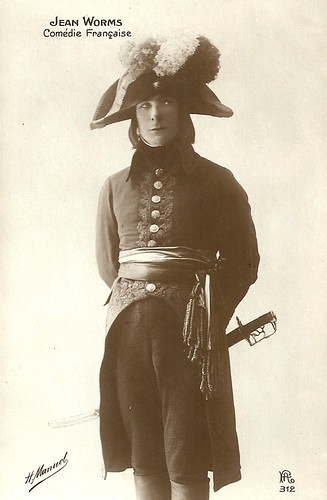
French postcard by FA, no. 312. Photo: Henri Manuel. Jean Worms, Comédie Française. Worms dressed up in Napoleonic costume
Jean Worms (1884–1943) was a French stage and screen actor, who from 1910 acted in French silent film and peaked there in the late 1910s, while all through the 1930s he was a prolific and well-known actor in French sound film.
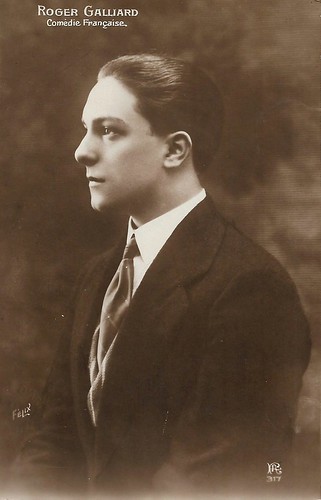
French postcard by FA, no. 317. Photo: Félix. Caption: Roger Galliard (sic), Comédie Française. Roger Gaillard's second name is misspelled on this card.
Roger Gaillard (1893-1970) was a French stage and screen actor. He was a respected actor at the Comédie-Française between 1916 and 1924 but mainly acted in cinema a decade after, in the 1930s French sound cinema. He was Pensionnaire at the Comédie-Française between 1916 and 1924, where he played in their classic repertory of Racine, Corneille, Shakespeare, and Victor Hugo, but also modern plays by e.g. Henri Bataille and Jean Serment.
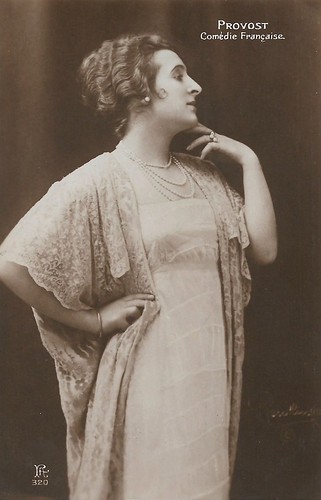
French postcard by FA, no. 320. Photo: Reutlinger. Caption: Provost, Comédie Française.
Jeanne Provost (1897-1980) was a member of the Comédie-Française only between 1907 and 1912. She would act in some 25 silent and sound films.
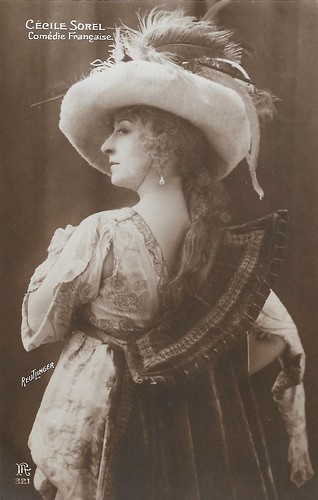
French postcard by FA, no. 321. Photo: Reutlinger. Caption: Cécile Sorel , Comédie Française.
Legendary actress Cécile Sorel (1873-1966) was the ‘queen of the French stage’ during the Belle Epoque, the period between the Paris Exposition of 1900 and the First World War. Her public appearances, often in extravagant costumes, created a sensation. During her long life, she played in five films. In 1901, she started to perform at the Comédie-Française, where she specialised in playing ‘grandes coquettes’. Her style was very recognisable, with her declamatory tone and articulated diction. It was also the style of Sarah Bernhardt. Like the latter, she is particularly associated with the role of the courtesan Célimène in 'Le Misanthrope' by Molière. Other success roles were 'La Dame aux camellias' and 'Marion Delorme' by Victor Hugo. In 1904, she was elected 339th Sociétaire of the Comédie-Française, and Sorel would remain there until 1933.
Sources: Comédie-Française (French), and Wikipedia.

French postcard by FA, no. 2:1. Photo: Reutlinger. Caption: Robinne et Alexandre, Comédie Française.
Comédie Française actress Gabrielle Robinne (1886-1980) or Robinne was one of the first French film stars. The peak of her film career was in the 1910s when she starred in mundane and romantic dramas by Pathé. With her blond hair, passionate eyes and elegant posture, she was the perfect ‘femme du monde’. Robinne entered the Comédie-Française in 1907. She became a Societaire in 1924 and stayed there until 1938. In addition to her beauty, her versatility made her one of the most active and popular actresses on the French stage.
René Alexandre (1885-1946) or Alexandre was a French actor of the Comédie-Française. Between 1909 and 1940, he acted in some 53 films, mainly shorts by Pathé but also André Antoine’s rural drama La Terre (1921). In 1908, he entered the Comédie-Française, where he was a Sociétaire between 1920 and 1944 and became Sociétaire Honoraire in 1945. His repertory included the classics of Racine, Molière, Shakespeare and Victor Hugo, but also more modern authors such as Henri Lavedan, Paul Feerier, and Henri Marx.

French postcard by FA, no. 21. Photo: Henri Manuel. Caption: Julia Bartet, Comédie Française.
Julia Bartet (1854-1941) was a member (1879) and sociétaire (1880) of the Comédie Française, where she was one of the big stars of her time. She retired in 1919. She played in three Film d'Art films: Le Retour d'Ulysse (1908), Rival de son père (1910), and Louis XI (1910).

French postcard by FA, no. 32. Photo: Talbot. Caption: Faber, Comédie Française.
Jane Faber (1880-1968) was a Belgian actress, who was active in French cinema of the 1910s and is best known for her role as Princess Sonia Danidoff in the crime serial Fantomas (Louis Feuillade, 1913-1914). She was also a notable actress of the Comédie-Française, from 1910 (then becoming the 268th resident of the institution) to 1951. Among the many plays she performed at the Comédie-Française were Jules Renard's 'Poil de carrote' (1912), with Léon Bernard and Marie Leconte, Molière's and Jean-Baptiste Lully's comedy-ballet 'L'Amour médecin' (1920), with Georges Berr, 'La Dispute' (1938) by Marivaux with Jean Martinelli, 'La Reine morte' (1942) by Henry de Montherlant, with Jean-Louis Barrault , as well as 'Tartuffe ou l'imposteur' (1949) by Molière, with Jean Yonnel.

French postcard by FA, no. 35. Photo: Henri Manuel. Albert Lambert Fils de la Comédie Française.
Albert Lambert (1865-1941), a.k.a. Albert Lambert fils, was a French stage and screen actor, who was for a long time part of the Comédie-Française, but also played in several early French Film d’Art films, first of all, L'Assassinat du Duc de Guise (André Calmettes, Charles Le Bargy, 1908).

French postcard by FA, no. 41. Photo: Henri Manuel, Paris. Caption: (René) Alexandre , Comédie Française.

French postcard by FA, no. 51. Photo (Henri) Manuel. Caption: Pièrat, Comédie Française.
Marie-Thérèse Piérat (1883-1934), whose real name was Marie Panot, was a member of a theatre family. In 1900 she started drama school at the Paris Conservatoire (for which she swapped her birth certificate with a younger, stillborn girl) and graduated in 1901, starting her career at the Odéon theatre. She became a member (1902), Sociétaire (1905) and Doyenne of the Comédie-Française, where she mingled the classic repertory with more modern plays by Bataille, Kistemaeckers, Ibsen and Bernstein. She starred in only one film, the French silent film Pour régner (André Luguet, 1926), for which she wrote the script herself. Her early death in 1934 because of angina pectoris (she was only 50) created a stir in the international press.

French postcard by FA, no. 57. Photo: Félix. Caption: Paul Mounet, Comédie Française.
Paul Mounet (1847–1922), born Jean-Paul Mounet, was a French actor of the Comédie Française, who also acted in various film d'art films around 1910. He was the younger brother of actor Jean Mounet-Sully.

French postcard by FA, no. 58. Photo: Félix, Paris. Caption: (Gabrielle) Robinne , Comédie Française.

French postcard by FA, no. 71. Photo: A. Bert. Caption: Grant (sic), Comédie Française. Georges Grand's last name is misspelled.
Valentin Pierre Louis MacLeod, better known as Georges Grand (1864-1921), was a French stage and screen actor, who was first an acclaimed actor with André Antoine before becoming a reputed actor of the Comédie Française. He also acted in 11 modern and historical dramas by Pathé Frères. In 1906, he entered the Comédie-Française. Here he was Sociétaire between 1908 and 1921 and mostly played in modern repertory by Paul Hervieu, Eugène Brieux, Henry Bataille, Henry Kistemaeckers, etc.

French postcard by FA, no. 86. Photo Félix. Caption: Paul Numa, Comédie Française.
Paul Jules Numa Haëring named Paul Numa (1865-1953) was a French stage and screen actor. He was a Pensionnaire at the Comédie Française, but unclear is when this started. He remained attached to it for decades, and for sure even in the years 1927-1932 he was still Pensionnaire, but he never became one of the Sociétaires.

French postcard by FA, no. 94. Photo: Henri Manuel. Caption: Firmin Gémier, Comédie Française.
Firmin Gémier (1869-1933) was actor, director and theatre manager at the French stage, promotor of the Théâtre Populaire and founder of the first Théâtre National Populaire (Paris 1920). He also acted in the French silent and sound cinema of the 1910s to the 1930s.

French postcard by F.A. (F.A. Christensen), no. 150. Photo: A. Bert, Paris. Caption: Georges Berr, Comédie Française.
Georges Berr (1867-1942) was a French actor and dramatist, and a member and Sociétaire of the Comédie-Française from 1886 to 1923. Under the pseudonyms Colias and Henry Bott he wrote several plays, particularly in collaboration with Louis Verneuil. While he only acted in one film, Les précieuses ridicules (1910), directed by himself, and only directed one other film, L'enfant prodigue (1909), both for Pathé Frères, Berr was a most active playwright whose plays were often adapted for the cinema, such as Le Million (René Clair, 1931), scripted by Clair and Berr himself. Berr worked on three other film scenarios, while he was the dialogue writer for four more films, including La porteuse de pain (René Sti, 1934). He was Jean-Pierre Aumont 's uncle.

French postcard by FA, no. 203. Photo: A. Bert. Caption: Jules Leitner as Alceste in the play 'The Misanthrope' by Moliere, performed at the Comédie Française in August 1908.
Jules-Louis-Auguste Leitner (1862-1940) was a French stage actor of the Comédie Française. Leitner acted in a few films of the company Film d'Art, including Jésus de Nazareth (André Calmettes, Henri Desfontaines, 1911).

French postcard by FA, no. 208. Photo: A. Bert. Caption: Georges Berr as 'Le bon roi Dagobert' at the Comédie Française.
Georges Berr (1867-1942) in Paris, was a French actor and dramatist, a member and Sociétaire of the Comédie-Française from 1886 to 1923. Under the pseudonyms Colias and Henry Bott he wrote several plays, particularly in collaboration with Louis Verneuil. He was Jean-Pierre Aumont's uncle. While he only acted in one film, Les précieuses ridicules (1910), directed by himself, and only directed one other film, L'enfant prodigue (1909), both for Pathé Frères, Berr was a most active playwright whose plays were often adapted for the cinema, such as Le Million, filmed by René Clair, and scripted by Clair and Berr himself. Berr worked on three other film scenarios, while he was the dialogue writer for four more films, including La porteuse de pain (René Sti, 1934).

French postcard by FA, no. 219. Photo: A. Bert. Caption: Jacques Fenoux, Comédie Française.
Jacques Fenoux (1870-1930) entered the Comédie-Française in 1895, became a Sociétaire in 1906, retired in 1924, and became a Sociétaire Honoraire in 1925. As the site of the Comédie states: "Fenoux was the type of a conscientious member, able to move effortlessly from one job to another, from small to large parts. He was appointed honorary member in 1925 but continued to play until his last days. He barely disappeared two weeks after having last interpreted Bazile, from The Barber of Seville." As far is known, his only performance was in Jacques de Féraudy's film Molière, sa vie, son oeuvre (1922), in which actors of the Comédie Française can be seen rehearsing plays by Molière.

French postcard by FA, no. 223. Photo: A. Bert. Caption: Mme. Silvain, Comédie Française.
Louise Silvain (1874-1930) entered the Comédie Française in 1901, became sociétaire in 1910 and sociétaire honoraire in 1925. She was married to Eugène Silvain, aka Sylvain. She acted in the films Une scène d'Andromaque à la Comédie Française (dir. unknown, 1909) and Molière, sa vie, son oeuvre (Jacques de Féraudy, 1922).

French postcard by FA, no. 262. Photo: H. Manuel. Caption: Piérat, Comédie Française.

French postcard by FA, no. 275. Photo: Félix. Caption: Colonna Romano, Comédie Française.
French stage actress (Gabrielle) Colonna-Romano (1883-1981) was a pupil of Sarah Bernhardt and a famous tragedienne of the Comédie-Française from 1913 till 1936. She also appeared in Film d'Art shorts and other early silent films. Her love life was tempestuous and legendary.

French postcard by FA, no. 312. Photo: Henri Manuel. Jean Worms, Comédie Française. Worms dressed up in Napoleonic costume
Jean Worms (1884–1943) was a French stage and screen actor, who from 1910 acted in French silent film and peaked there in the late 1910s, while all through the 1930s he was a prolific and well-known actor in French sound film.

French postcard by FA, no. 317. Photo: Félix. Caption: Roger Galliard (sic), Comédie Française. Roger Gaillard's second name is misspelled on this card.
Roger Gaillard (1893-1970) was a French stage and screen actor. He was a respected actor at the Comédie-Française between 1916 and 1924 but mainly acted in cinema a decade after, in the 1930s French sound cinema. He was Pensionnaire at the Comédie-Française between 1916 and 1924, where he played in their classic repertory of Racine, Corneille, Shakespeare, and Victor Hugo, but also modern plays by e.g. Henri Bataille and Jean Serment.

French postcard by FA, no. 320. Photo: Reutlinger. Caption: Provost, Comédie Française.
Jeanne Provost (1897-1980) was a member of the Comédie-Française only between 1907 and 1912. She would act in some 25 silent and sound films.

French postcard by FA, no. 321. Photo: Reutlinger. Caption: Cécile Sorel , Comédie Française.
Legendary actress Cécile Sorel (1873-1966) was the ‘queen of the French stage’ during the Belle Epoque, the period between the Paris Exposition of 1900 and the First World War. Her public appearances, often in extravagant costumes, created a sensation. During her long life, she played in five films. In 1901, she started to perform at the Comédie-Française, where she specialised in playing ‘grandes coquettes’. Her style was very recognisable, with her declamatory tone and articulated diction. It was also the style of Sarah Bernhardt. Like the latter, she is particularly associated with the role of the courtesan Célimène in 'Le Misanthrope' by Molière. Other success roles were 'La Dame aux camellias' and 'Marion Delorme' by Victor Hugo. In 1904, she was elected 339th Sociétaire of the Comédie-Française, and Sorel would remain there until 1933.
Sources: Comédie-Française (French), and Wikipedia.
Published on May 01, 2020 22:00
April 30, 2020
Violet Hopson
Australian-born actress and producer Violet Hopson (1887-1973) was one of the first British film stars. For companies like Hepworth and Broadwest, she starred with Stewart Rome in a string of dramas. Violet Hopson appeared in more than 100 British silent films and occasionally played supporting roles in sound pictures of the early 1930s.
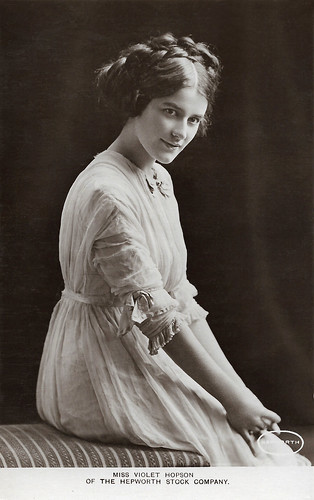
British postcard. Photo: Hepworth. Caption: Miss Violet Hopson of the Hepworth Stock Company.
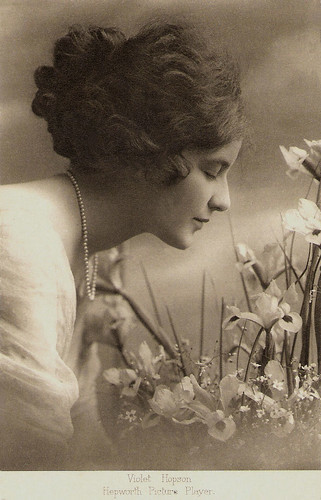
British postcard in the Hepworth Picture Player series. Photo: Hepworth.
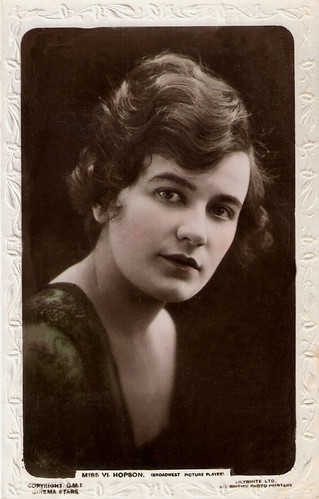
British postcard in the Cinema Stars series by Lilywhite Ltd. Photo: Broadwest.
Dear Delightful Villainess
Violet Hopson was born as Elma Kate Victoria Karkeek in Port Augusta, South Australia, Australia in 1887. Violet's earliest performances were with the Pollard Opera Company in Australia and New Zealand from 1898 on. In 1900 she went to America with her older sister Zoe Karkeek. Zoe and Wilmot Karkeek were long-standing members of this company from 1892. Violet was known as Kate or Kitty to her family at this stage in her life.
In 1909, at the age of 21, she married actor Alec Worcester (a.k.a. Alexander Howitt Worster) in 1909, and they had two children Alexander Nicholas Howitt (1910) and Jessica Yvonne Howitt (1913). She made her film debut probably in the short British ‘fat man comedy’ Mr. Tubby's Triumph (David Aylott, 1910) as the wife of Mr. Tubby (Johnny Butt) for Cricks & Martin Films.
Two years later she moved over to Hepworth Pictures, where she made such short comedies as The Umbrella They Could Not Lose (Frank Wilson, 1912), Love in a Laundry (Frank Wilson, 1912) with husband Alec Worcester, and The Stolen Picture (Frank Wilson, 1912). Soon Cecil Hepworth cast her in other genres such as the crime drama The Jewel Thieves Outwitted (Frank Wilson, 1913) in which jewel thief Jack Hulcup is chased by motor-car and airplane, or the historical drama Drake's Love Story (Hay Plumb, 1913) in which she played Queen Elizabeth.
She played opposite other Hepworth stars such as Alma Taylor in the comedy A Little Widow Is a Dangerous Thing (Frank Wilson, 1913), Chrissie White in the drama The Vicar of Wakefield (Frank Wilson, 1913), and Stewart Rome in The Heart of Midlothian (Frank Wilson, 1914). In the years of WWI, she appeared in dozens of such short films for Hepworth. She soon became a major star of the silent British cinema of the 1910s. The audiences nicknamed her the ‘Dear Delightful Villainess’.
In 1917 she moved over to director-producer Walter West at his production company Broadwest. She appeared in such Broadwest productions as the sports drama A Gamble for Love (Frank Wilson, 1917), the crime film The Woman Wins (Frank Wilson, 1918), and the war film Sisters in Arms (Walter West, 1918). Then Stewart Rome was also lured from Hepworth to Broadwest and Hopson appeared in a string of dramas with her old co-star. The first was probably My Son, My Son (1918) which also featured Jack Cardiff who later became a famous cameraman.
The new pairing with Stewart Rome had a follow up in the sports drama The Gentleman Rider (Walter West, 1919) also with Cameron Carr, Snow in the Desert (Walter West, 1919) with the young Ronald Colman in a supporting part, A Daughter of Eve (Walter West, 1919), The Romance of a Movie Star (Richard Garrick, 1920), the mystery The Case of Lady Camber (Walter West, 1920), Her Son (Walter West, 1920) with her son Nicholas as her film son, The Imperfect Lover (Walter West, 1921), When Greek Meets Greek (Walter West, 1922) and The White Hope (Walter West, 1922). These films were all produced by Walter West for Broadwest and later for Walter West Productions.
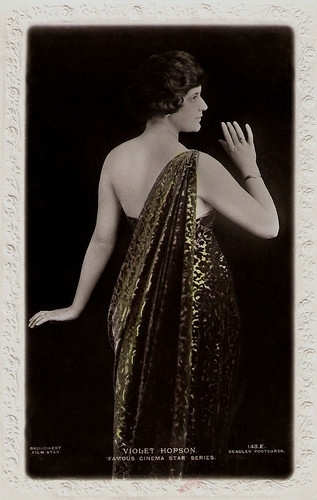
British postcard in the 'Famous Cinema Star' series by J. Beagles & Co. Ltd., London, no. 143 E. Photo: Broadwest.
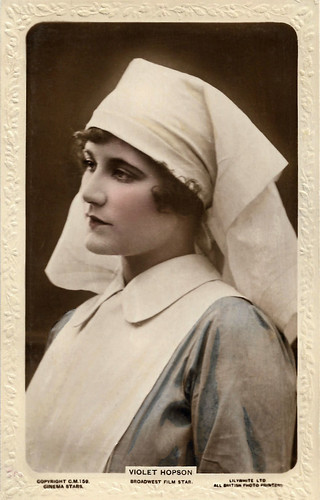
British postcard in the 'Cinema Stars' Series by Lilywhite Ltd, London, no. CM 159. Photo: Broadwest. Violet Hopson in The Case of Lady Camber (Walter West, 1920).
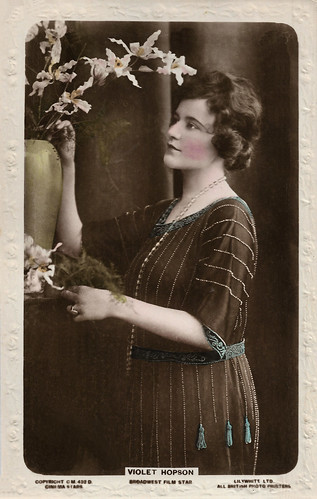
British postcard in the 'Cinema Stars' Series by Lilywhite Ltd, London, no. CM 432 D. Photo: Broadwest.
Pioneer in the British Film World
Violet Hopson divorced Alec Worcester in February 1919 on the ground of his adultery and desertion. Wikipedia cites a December 1921 biography in Motion Picture Studio in which is suggested that she “had a breakdown which caused her to leave the stage and turn to films”. This biography has to be unreliable though because it cites her Californian birth falsely (researcher Janice Healey contradicted it by genealogical research in the Australia Birth Index) and Hopson turned to film already in 1910.
Hopson announced in Motion Picture Studio “that she has completed the biggest deal yet attempted by a woman in British film land” by selling the rights of her films for two years to Butchers. Hopson now owned her own production company Violet Hopson Productions and can be thus considered as a pioneer in the British film world. However, she produced and starred in only one film, The Scarlet Lady (Walter West, 1922).
According to IMDb , she starred in the following years in films produced by Walter West Productions, such as the sports drama Beautiful Kitty (Walter West, 1923), The Stirrup Cup Sensation (Walter West, 1924) with Stewart Rome , and The Great Turf Mystery (Walter West, 1924) with Warwick Ward .
Her next films, A Daughter of Love (1925) for Stoll Picture Production and Beating the Book (1926) for C&M Productions were again directed by West. Probably Walter West had gone bankrupt. In his bankruptcy papers, he claimed to have married Violet. It’s unclear if this is true.
Thomas Staedeli at Cyranos writes that West was indeed her husband. If so, it was probably after this divorce that she suffered a breakdown, as indicated by Wikipedia . Her last silent film was Widecomb Fair (Norman Walker, 1929) in which she played a supporting part. Occasionally, she later appeared in early sound pictures. Her final film was One Precious Year (Henry Edwards, 1933) with Basil Rathbone.
After that, she retired from the film business. Violet Hopson died as (as Elma Kate Worster) in 1973 in a London hospital at the age of 85.
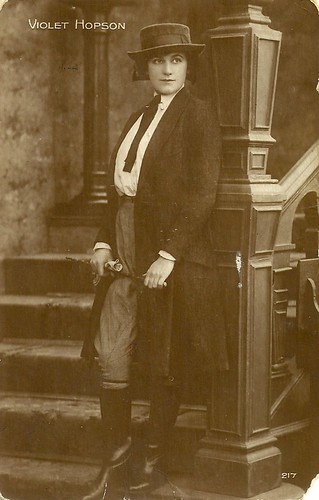
French postcard by Editions Cinémagazine, no. 217.
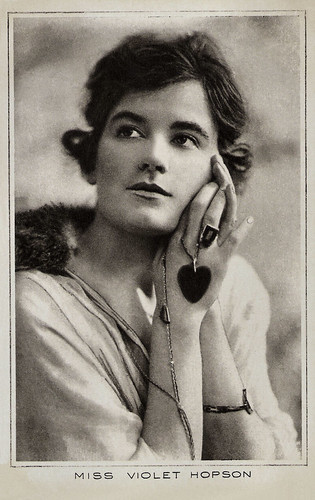
British postcard in the 'Pictures Portrait Gallery' by Pictures, Ltd, London, no. 36. Photo: Claude Harris, Ltd.
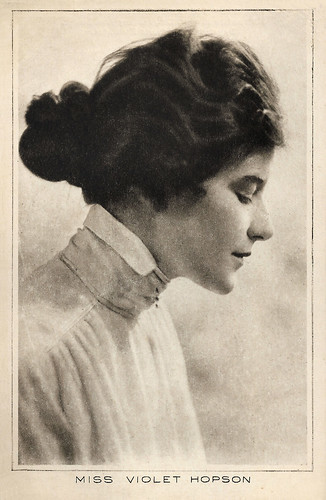
British postcard in the 'Pictures Portrait Gallery' by Pictures, Ltd, London, no. 37. Photo: Claude Harris, Ltd.
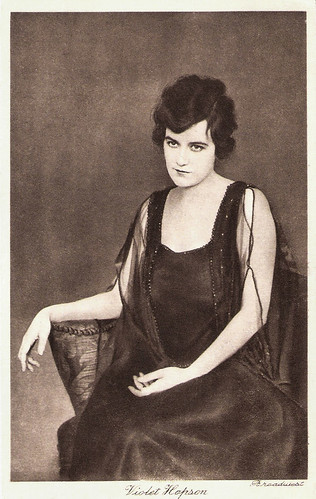
British postcard. Photo: Broadwest.
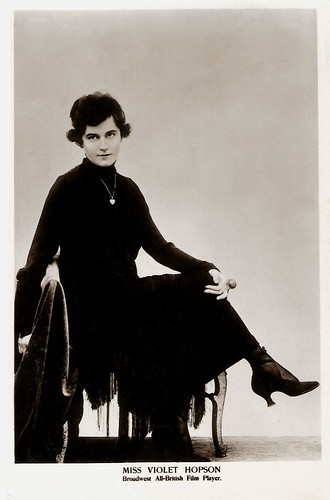
British postcard. Photo: Broadwest.
Sources: Thomas Staedeli (Cyranos), BritMovie, Women and Silent British Cinema, Wikipedia and .

British postcard. Photo: Hepworth. Caption: Miss Violet Hopson of the Hepworth Stock Company.

British postcard in the Hepworth Picture Player series. Photo: Hepworth.

British postcard in the Cinema Stars series by Lilywhite Ltd. Photo: Broadwest.
Dear Delightful Villainess
Violet Hopson was born as Elma Kate Victoria Karkeek in Port Augusta, South Australia, Australia in 1887. Violet's earliest performances were with the Pollard Opera Company in Australia and New Zealand from 1898 on. In 1900 she went to America with her older sister Zoe Karkeek. Zoe and Wilmot Karkeek were long-standing members of this company from 1892. Violet was known as Kate or Kitty to her family at this stage in her life.
In 1909, at the age of 21, she married actor Alec Worcester (a.k.a. Alexander Howitt Worster) in 1909, and they had two children Alexander Nicholas Howitt (1910) and Jessica Yvonne Howitt (1913). She made her film debut probably in the short British ‘fat man comedy’ Mr. Tubby's Triumph (David Aylott, 1910) as the wife of Mr. Tubby (Johnny Butt) for Cricks & Martin Films.
Two years later she moved over to Hepworth Pictures, where she made such short comedies as The Umbrella They Could Not Lose (Frank Wilson, 1912), Love in a Laundry (Frank Wilson, 1912) with husband Alec Worcester, and The Stolen Picture (Frank Wilson, 1912). Soon Cecil Hepworth cast her in other genres such as the crime drama The Jewel Thieves Outwitted (Frank Wilson, 1913) in which jewel thief Jack Hulcup is chased by motor-car and airplane, or the historical drama Drake's Love Story (Hay Plumb, 1913) in which she played Queen Elizabeth.
She played opposite other Hepworth stars such as Alma Taylor in the comedy A Little Widow Is a Dangerous Thing (Frank Wilson, 1913), Chrissie White in the drama The Vicar of Wakefield (Frank Wilson, 1913), and Stewart Rome in The Heart of Midlothian (Frank Wilson, 1914). In the years of WWI, she appeared in dozens of such short films for Hepworth. She soon became a major star of the silent British cinema of the 1910s. The audiences nicknamed her the ‘Dear Delightful Villainess’.
In 1917 she moved over to director-producer Walter West at his production company Broadwest. She appeared in such Broadwest productions as the sports drama A Gamble for Love (Frank Wilson, 1917), the crime film The Woman Wins (Frank Wilson, 1918), and the war film Sisters in Arms (Walter West, 1918). Then Stewart Rome was also lured from Hepworth to Broadwest and Hopson appeared in a string of dramas with her old co-star. The first was probably My Son, My Son (1918) which also featured Jack Cardiff who later became a famous cameraman.
The new pairing with Stewart Rome had a follow up in the sports drama The Gentleman Rider (Walter West, 1919) also with Cameron Carr, Snow in the Desert (Walter West, 1919) with the young Ronald Colman in a supporting part, A Daughter of Eve (Walter West, 1919), The Romance of a Movie Star (Richard Garrick, 1920), the mystery The Case of Lady Camber (Walter West, 1920), Her Son (Walter West, 1920) with her son Nicholas as her film son, The Imperfect Lover (Walter West, 1921), When Greek Meets Greek (Walter West, 1922) and The White Hope (Walter West, 1922). These films were all produced by Walter West for Broadwest and later for Walter West Productions.

British postcard in the 'Famous Cinema Star' series by J. Beagles & Co. Ltd., London, no. 143 E. Photo: Broadwest.

British postcard in the 'Cinema Stars' Series by Lilywhite Ltd, London, no. CM 159. Photo: Broadwest. Violet Hopson in The Case of Lady Camber (Walter West, 1920).

British postcard in the 'Cinema Stars' Series by Lilywhite Ltd, London, no. CM 432 D. Photo: Broadwest.
Pioneer in the British Film World
Violet Hopson divorced Alec Worcester in February 1919 on the ground of his adultery and desertion. Wikipedia cites a December 1921 biography in Motion Picture Studio in which is suggested that she “had a breakdown which caused her to leave the stage and turn to films”. This biography has to be unreliable though because it cites her Californian birth falsely (researcher Janice Healey contradicted it by genealogical research in the Australia Birth Index) and Hopson turned to film already in 1910.
Hopson announced in Motion Picture Studio “that she has completed the biggest deal yet attempted by a woman in British film land” by selling the rights of her films for two years to Butchers. Hopson now owned her own production company Violet Hopson Productions and can be thus considered as a pioneer in the British film world. However, she produced and starred in only one film, The Scarlet Lady (Walter West, 1922).
According to IMDb , she starred in the following years in films produced by Walter West Productions, such as the sports drama Beautiful Kitty (Walter West, 1923), The Stirrup Cup Sensation (Walter West, 1924) with Stewart Rome , and The Great Turf Mystery (Walter West, 1924) with Warwick Ward .
Her next films, A Daughter of Love (1925) for Stoll Picture Production and Beating the Book (1926) for C&M Productions were again directed by West. Probably Walter West had gone bankrupt. In his bankruptcy papers, he claimed to have married Violet. It’s unclear if this is true.
Thomas Staedeli at Cyranos writes that West was indeed her husband. If so, it was probably after this divorce that she suffered a breakdown, as indicated by Wikipedia . Her last silent film was Widecomb Fair (Norman Walker, 1929) in which she played a supporting part. Occasionally, she later appeared in early sound pictures. Her final film was One Precious Year (Henry Edwards, 1933) with Basil Rathbone.
After that, she retired from the film business. Violet Hopson died as (as Elma Kate Worster) in 1973 in a London hospital at the age of 85.

French postcard by Editions Cinémagazine, no. 217.

British postcard in the 'Pictures Portrait Gallery' by Pictures, Ltd, London, no. 36. Photo: Claude Harris, Ltd.

British postcard in the 'Pictures Portrait Gallery' by Pictures, Ltd, London, no. 37. Photo: Claude Harris, Ltd.

British postcard. Photo: Broadwest.

British postcard. Photo: Broadwest.
Sources: Thomas Staedeli (Cyranos), BritMovie, Women and Silent British Cinema, Wikipedia and .
Published on April 30, 2020 22:00
April 29, 2020
Dranem
Dranem (1869-1935) was a French comic singer, stage and film actor who was active in variety shows, café-concerts, and in operettas. He already appeared in Pathé film shorts in the early 1900s. The advent of sound film in the late 1920s made Dranem again much in demand for screen roles.
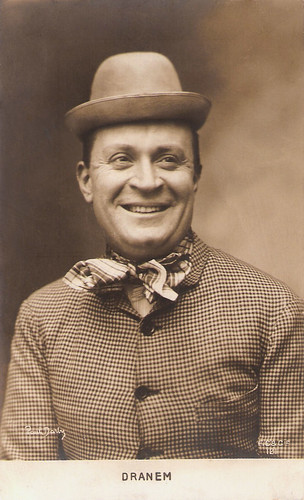
French postcard by F.C. & Cie., no. 121. Photo: Paul Darly.
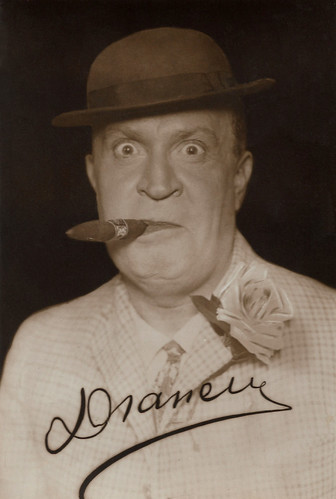
French postcard.
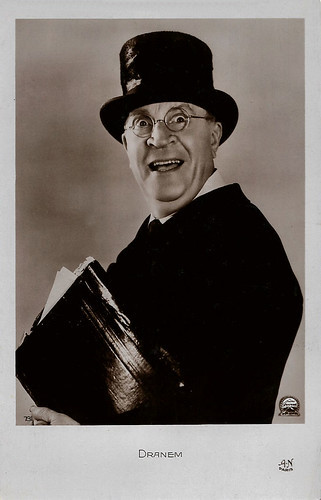
French postcard by A.N., Paris, no. 79. Photo: Paramount.
His own comic absurdist genre
Armand Dranem or simply Dranem was born Charles Armand Ménard, in Paris, in 1869. He was the son of a craftsman-jeweler.
He was very early attracted by the café-concert. In September 1890, he launched himself on a local amateur stage, La Verrerie. He adopted the singular stage name of Dranem, an anagram of Menard. After his military service, he began working as an apprentice jeweler in a local shop and then became a seller of orthopedic instruments.
In 1894, Dranem made his professional stage debut at the Concert de l'Epoque. In 1895, he performed with fellow newcomers Félix Mayol and Max Dearly in the Concert Parisien.
One day in 1896, at the Carreau du Temple, he started to wear a strange outfit: a small skimpy jacket, yellow and green striped pants which are too wide and too short, enormous shoes without laces and a strange little hat. With his cheeks and nose covered in red, he came running on stage as if chased. He started to sing with his eyes closed, which he opened only to simulate the fear of spouting such incongruities. It was a triumph.
The genus Dranem was born. from where he went on to become a leading music hall entertainer in his own comic absurdist genre. In 1899, he was signed to perform at the famous Eldorado Club, the temple of the café-concert. There he appeared regularly for the next twenty years. Dranem's comedic singing routine brought a loyal following and his work made him a very wealthy man.
He also appeared under the direction of the director Antoine in Molière's comedy 'Le médecin malgré lui', at l'Odéon, in 1910. The critics reacted with rave reviews.
In 1910 he purchased the Château de Ris in the town of Ris-Orangis south of Paris and established a charitable foundation to operate the large building as a senior citizens home for retired performers. President Armands Fallières opened the home in 1911. On the grounds, a bandstand and an open-air theatre provided entertainment.
He then turned to the operetta. He shared the poster with Maurice Chevalier in 'Là-Haut' and shone in many musicals written by Albert Willemetz.
His Dranem Foundation continued to operate until the year 2000 and the property remains a government-operated retirement home open to all members of the public. During World War I, Dranem continued his benevolence by performing for the troops at music halls and for wounded soldiers at military hospitals.
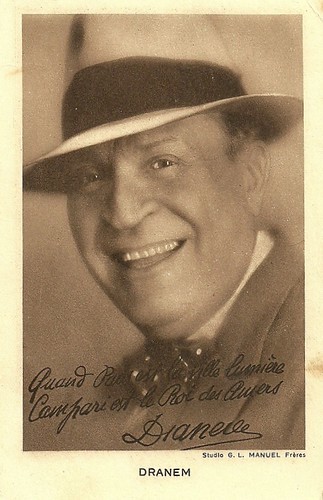
French postcard. Photo Studio G.L. Manuel Frères. "Quand Paris est la ville lumière, Campari est le Roi des Amers."
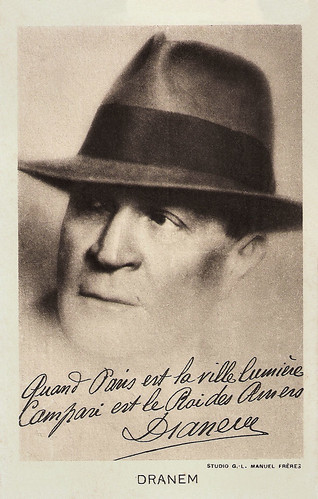
French postcard by David Campari, Paris. Photo: Studio G.L. Manuel Frères. Caption: Quand Paris est la ville lumière, Campari est le Roi des Amers.
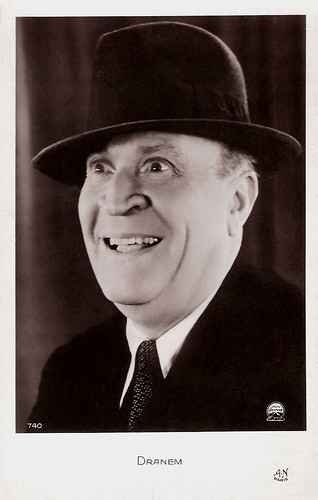
French postcard by A.N., Paris, no. 740. Photo: Paramount.
A very energetic performer
Dranem also acted and sang in live theatre and in film. According to Alison McMahan in her study on Alice Guy, Dranem already acted in 1900 in the Pathé silent Ma Tante/My Aunt, though Laurent Mannoni in the Encyclopedia of Early Cinema dates this film as 1903.
According to Mannoni, Pathé launched his film career in 1901 with Le salut de Dranem/Dranem's Salute (Ferdinand Zecca, 1901), followed by several silent shorts by Pathé, sometimes with Dranem in drag, but often Dranem as the title character as well. Mannoni mentions Histoire grivoise racontée par une concierge/Saucy Story as Told by the Concierge (?, 1902), Ma Tante/My Aunt (Ferdinand Zecca, 1903), Le mitron/The Baker's Boy (Ferdinand Zecca, 1904), Le rêve de Dranem/Dranem's Dream (Ferdinand Zecca, 1906) to Le tondeur galant/The Gallant Shearer (1912).
IMDb also lists Les souliers de Dranem/Dranem's shoes (Ferdinand Zecca, 1908), Dranem fait ressemeler ses ribouis (?, 1910), Le mariage de Dranem/Dranem's wedding (Ferdinand Zecca, 1912) and Dranem sténo-dactyle/Shorthand Typist Dranem (?, 1912), and the Molière adaptation Le médecin malgré lui/The doctor in spite of himself (?, 1913). McMahan also mentions Man Eating Pomegranates (1903).
In 1905, Dranem also performed in a series of 11 early sound films, 'Phonoscènes', directed by Alice Guy for Gaumont: Allumeur Marche, Le trou de mon quai, Valsons, V'la retameur, Les p'tits pois, L'enfant du cordonnier, Etre légume, Le cucurbitacée, Le boléro cosmopolite, Bonsoir, M'sieurs, dames, Le Vrai Jiu-jitsu, and Five O'Clock Tea.
Alison MacMahan writes: "Dranem was a very energetic performer, moving around the entire stage, combining whole body language with pantomime and caricature. Although he wore the same 'bum' or 'clown' costume in each of his films, he had a different prop (a bucket, a poncho, a vegetable) in each one."
In the 1920s Dranem only acted in two films: he had a small part in La clé de voute/The Keystone (Roger Lion, 1925) with Gina Palerme , but he had the lead in the late silent comedy J'ai l'noir ou Le suicide Dranem/Dranem's suicide (Max de Rieux, 1929), in which Dranem is an unfortunate ostrich breeder.
The advent of synchronised sound film in the late 1920s made Dranem much in demand for screen roles featuring his singing routines.
In the early 1930s, he played in some 13 films, from which several with himself in the lead, such as La poule/The Hen (René Guissart, 1932) with Arlette Marchal , and Ah! Quelle gare!/Ah! What a station! (René Guissart, 1933) with Jeanne Boitel, or at least as the main male antagonist. Dranem acted in the sound film until his death.
In 1891, Dranem married Lucie Isembert, who after a union of twenty-two years requested and obtained a separation in 1916 from bed and board and ordered her husband to pay a pension of 500 francs per month. IMDb mentions Ana Ruiz y Miyares as his wife from 1918 till 1923. In 1923 he met singer and actress Suzette O'Nill. They married in 1927, and he adopted her daughter, Francis Florence O'Neill (1921). The couple stayed together till his death.
Dranem died in Paris in 1935 at the age of sixty-six and was buried at the Château de Ris. That same year, he was appointed Knight of the Legion of Honor. At his request, he is buried in the park of Ris Orangis with his wife.
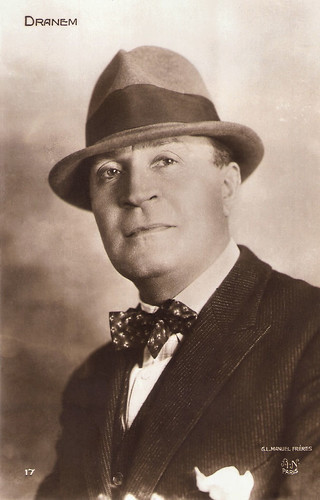
French postcard. A.N [Noyer], Paris, No. 17. Photo G.L. Manuel Frères, Paris.
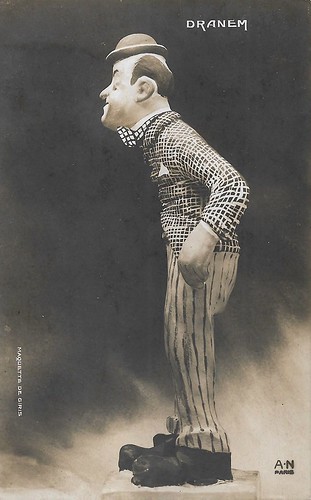
French postcard by A.N., Paris. 'Maquette de Giris'.
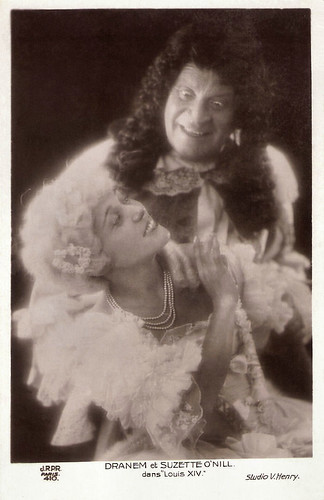
French postcard by J.R.P.R., Paris, no. 410. Photo: Studio V. Henry. Dranem and Suzette O'Nill in the stage operetta 'Louis XIV' (1929)
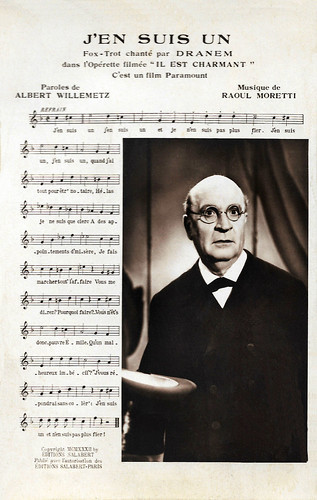
French card by Editions Salabert, Paris, 1932. Photo: Paramount. Dranem sings the foxtrot 'J'en suis un' in the operetta film Il est Charmant/He Is Charming (Louis Mercanton, 1932). Words: Albert Willemetz. Music: Raoul Moretti.
Sources: Alison McMahan (Alice Guy-Blaché. Lost Visionary of the Cinema), Laurent Mannoni (Encyclopedia of Early Cinema), Wikipedia (English and French), and .

French postcard by F.C. & Cie., no. 121. Photo: Paul Darly.

French postcard.

French postcard by A.N., Paris, no. 79. Photo: Paramount.
His own comic absurdist genre
Armand Dranem or simply Dranem was born Charles Armand Ménard, in Paris, in 1869. He was the son of a craftsman-jeweler.
He was very early attracted by the café-concert. In September 1890, he launched himself on a local amateur stage, La Verrerie. He adopted the singular stage name of Dranem, an anagram of Menard. After his military service, he began working as an apprentice jeweler in a local shop and then became a seller of orthopedic instruments.
In 1894, Dranem made his professional stage debut at the Concert de l'Epoque. In 1895, he performed with fellow newcomers Félix Mayol and Max Dearly in the Concert Parisien.
One day in 1896, at the Carreau du Temple, he started to wear a strange outfit: a small skimpy jacket, yellow and green striped pants which are too wide and too short, enormous shoes without laces and a strange little hat. With his cheeks and nose covered in red, he came running on stage as if chased. He started to sing with his eyes closed, which he opened only to simulate the fear of spouting such incongruities. It was a triumph.
The genus Dranem was born. from where he went on to become a leading music hall entertainer in his own comic absurdist genre. In 1899, he was signed to perform at the famous Eldorado Club, the temple of the café-concert. There he appeared regularly for the next twenty years. Dranem's comedic singing routine brought a loyal following and his work made him a very wealthy man.
He also appeared under the direction of the director Antoine in Molière's comedy 'Le médecin malgré lui', at l'Odéon, in 1910. The critics reacted with rave reviews.
In 1910 he purchased the Château de Ris in the town of Ris-Orangis south of Paris and established a charitable foundation to operate the large building as a senior citizens home for retired performers. President Armands Fallières opened the home in 1911. On the grounds, a bandstand and an open-air theatre provided entertainment.
He then turned to the operetta. He shared the poster with Maurice Chevalier in 'Là-Haut' and shone in many musicals written by Albert Willemetz.
His Dranem Foundation continued to operate until the year 2000 and the property remains a government-operated retirement home open to all members of the public. During World War I, Dranem continued his benevolence by performing for the troops at music halls and for wounded soldiers at military hospitals.

French postcard. Photo Studio G.L. Manuel Frères. "Quand Paris est la ville lumière, Campari est le Roi des Amers."

French postcard by David Campari, Paris. Photo: Studio G.L. Manuel Frères. Caption: Quand Paris est la ville lumière, Campari est le Roi des Amers.

French postcard by A.N., Paris, no. 740. Photo: Paramount.
A very energetic performer
Dranem also acted and sang in live theatre and in film. According to Alison McMahan in her study on Alice Guy, Dranem already acted in 1900 in the Pathé silent Ma Tante/My Aunt, though Laurent Mannoni in the Encyclopedia of Early Cinema dates this film as 1903.
According to Mannoni, Pathé launched his film career in 1901 with Le salut de Dranem/Dranem's Salute (Ferdinand Zecca, 1901), followed by several silent shorts by Pathé, sometimes with Dranem in drag, but often Dranem as the title character as well. Mannoni mentions Histoire grivoise racontée par une concierge/Saucy Story as Told by the Concierge (?, 1902), Ma Tante/My Aunt (Ferdinand Zecca, 1903), Le mitron/The Baker's Boy (Ferdinand Zecca, 1904), Le rêve de Dranem/Dranem's Dream (Ferdinand Zecca, 1906) to Le tondeur galant/The Gallant Shearer (1912).
IMDb also lists Les souliers de Dranem/Dranem's shoes (Ferdinand Zecca, 1908), Dranem fait ressemeler ses ribouis (?, 1910), Le mariage de Dranem/Dranem's wedding (Ferdinand Zecca, 1912) and Dranem sténo-dactyle/Shorthand Typist Dranem (?, 1912), and the Molière adaptation Le médecin malgré lui/The doctor in spite of himself (?, 1913). McMahan also mentions Man Eating Pomegranates (1903).
In 1905, Dranem also performed in a series of 11 early sound films, 'Phonoscènes', directed by Alice Guy for Gaumont: Allumeur Marche, Le trou de mon quai, Valsons, V'la retameur, Les p'tits pois, L'enfant du cordonnier, Etre légume, Le cucurbitacée, Le boléro cosmopolite, Bonsoir, M'sieurs, dames, Le Vrai Jiu-jitsu, and Five O'Clock Tea.
Alison MacMahan writes: "Dranem was a very energetic performer, moving around the entire stage, combining whole body language with pantomime and caricature. Although he wore the same 'bum' or 'clown' costume in each of his films, he had a different prop (a bucket, a poncho, a vegetable) in each one."
In the 1920s Dranem only acted in two films: he had a small part in La clé de voute/The Keystone (Roger Lion, 1925) with Gina Palerme , but he had the lead in the late silent comedy J'ai l'noir ou Le suicide Dranem/Dranem's suicide (Max de Rieux, 1929), in which Dranem is an unfortunate ostrich breeder.
The advent of synchronised sound film in the late 1920s made Dranem much in demand for screen roles featuring his singing routines.
In the early 1930s, he played in some 13 films, from which several with himself in the lead, such as La poule/The Hen (René Guissart, 1932) with Arlette Marchal , and Ah! Quelle gare!/Ah! What a station! (René Guissart, 1933) with Jeanne Boitel, or at least as the main male antagonist. Dranem acted in the sound film until his death.
In 1891, Dranem married Lucie Isembert, who after a union of twenty-two years requested and obtained a separation in 1916 from bed and board and ordered her husband to pay a pension of 500 francs per month. IMDb mentions Ana Ruiz y Miyares as his wife from 1918 till 1923. In 1923 he met singer and actress Suzette O'Nill. They married in 1927, and he adopted her daughter, Francis Florence O'Neill (1921). The couple stayed together till his death.
Dranem died in Paris in 1935 at the age of sixty-six and was buried at the Château de Ris. That same year, he was appointed Knight of the Legion of Honor. At his request, he is buried in the park of Ris Orangis with his wife.

French postcard. A.N [Noyer], Paris, No. 17. Photo G.L. Manuel Frères, Paris.

French postcard by A.N., Paris. 'Maquette de Giris'.

French postcard by J.R.P.R., Paris, no. 410. Photo: Studio V. Henry. Dranem and Suzette O'Nill in the stage operetta 'Louis XIV' (1929)

French card by Editions Salabert, Paris, 1932. Photo: Paramount. Dranem sings the foxtrot 'J'en suis un' in the operetta film Il est Charmant/He Is Charming (Louis Mercanton, 1932). Words: Albert Willemetz. Music: Raoul Moretti.
Sources: Alison McMahan (Alice Guy-Blaché. Lost Visionary of the Cinema), Laurent Mannoni (Encyclopedia of Early Cinema), Wikipedia (English and French), and .
Published on April 29, 2020 22:00
April 28, 2020
Isa Pola
Photogenetic actress Isa Pola (1909-1984) became during the 1930s and 1940s a true diva of the Italian cinema. She showed her frankness and passion for acting in such films as La canzone dell'amore (1930), La telefonista (1932) and Vittorio de Sica's I bambini ci guardano (1943).
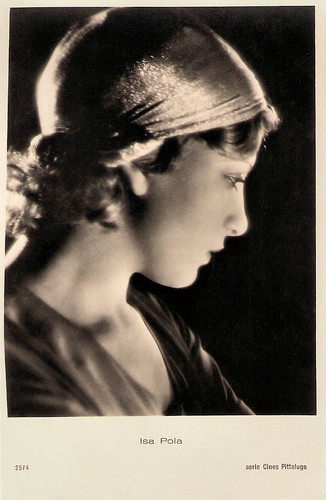
Italian postcard in the Cines Pittaluga series by Casa Edit. Ballerini & Fratini, Firenze, no. 2574. Photo: Cines Pittaluga.
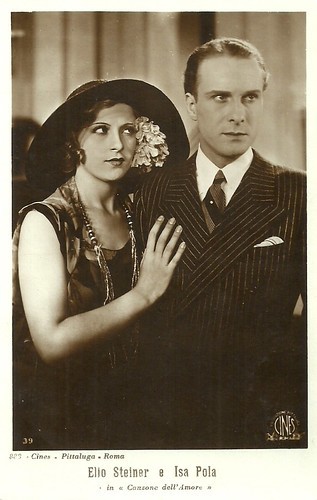
Italian postcard by Ed. G.B. Falci, Milano, no. 39. Photo: Cines. Pittaluga, Roma. Isa Pola and Elio Steiner in La canzone dell'amore (Gennaro Righelli, 1930).
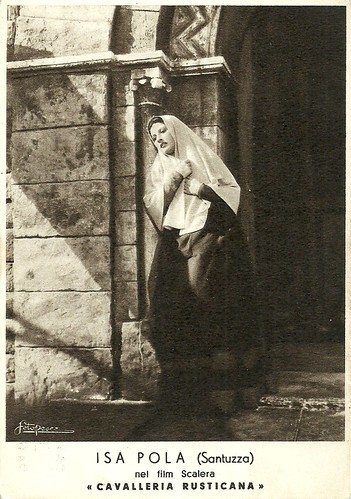
Italian postcard. Photo: Pesce / Scalera Film. Isa Pola as Santuzza in Cavalleria rusticana (Amleto Palermi, 1939).
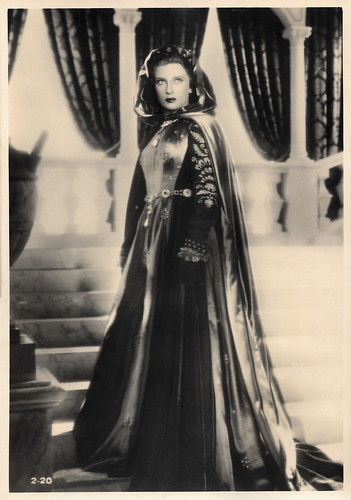
Italian postcard by Hector, no. 2.20, 1941. Photo: Pexce / Scalera Film. Isa Pola in Lucrezia Borgia (Hans Hinrich, 1940).
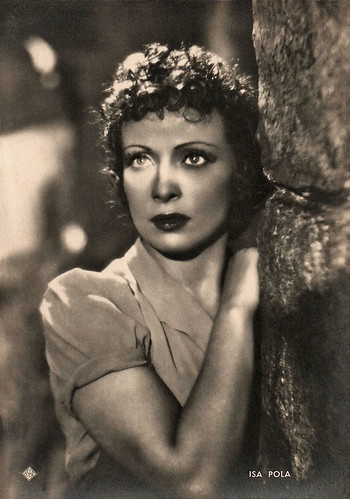
Italian card by ASER, Rome, no. 240. Photo: Pesce / Scalera Film. Isa Pola in Una signora dell'ovest/Girl of the Golden West (Carl Koch, 1942).
Something Captivating and Almost Perverse
Isa Pola was born Maria Luisa Betti di Montesano in Bologna, Italy in 1909. Isa had a passion for acting and cinema at an early stage, and picked as her stage name Pola. She was beautiful, photogenic, had something captivating and almost perverse.
She made her film debut with a small part in Martiri d'Italia/Martyrs of Italy (Domenico Gaido, 1927). Other small parts followed in which she was type-casted as the evil adventuress. This eventually lead to her first major part in Myriam (Enrico Guazzoni, 1928).
After the introduction of sound film, Pola’s career really took off. She played the antagonist of Dria Paola in the first Italian sound film La canzone dell’amore/The song of love (Gennaro Righelli, 1930). From that film on Pola became a true diva of the Italian sound cinema. With her photogenic qualities, frankness and pleasant voice she broke with the tradition of the languid divas of the silent era.
She continued her success throughout the 1930s with such hit films as Terra madre/Mother Earth (Alessandro Blasetti, 1931) opposite Leda Gloria , La Wally (Guido Brignone, 1931) featuring Germana Paolieri , L'ultima avventura/The Last Adventure (Mario Camerini, 1932), La telefonista/The switchboard Operator (Nunzio Malasomma, 1932), Acciaio/Steel (Walther Ruttmann, 1933) and the comedy L'anonima Roylott/The anonymous Roylott (Raffaello Matarazzo, 1936).
Her part as a serious and streetwise telephone operator in La telefonista contrasted with her previous vamp roles and gave her image a new, interesting twist. Thanks to this versatility, her career quickly marched on. As a popular diva of the Italian screens, she starred together with the big male stars of those years: Fosco Giachetti , Gino Cervi , Rossano Brazzi and Antonio Centa , alternating the type of the perfidious, insatiable woman with the honest and pious wife, and the defenseless girl with the adulterous bourgeois lady. She played Santuzza in Cavalleria rusticana (Amleto Palermi, 1939) opposite Leonardo Cortese as Turiddu, she performed the title role in Lucrezia Borgia (Hans Hinrich, 1940), and did the female lead of Arianna in the now lost Western Una signora dell’ovest/Girl of the Golden West (Carl Koch, 1942) with Michel Simon , Rossano Brazzi and Valentina Cortese .
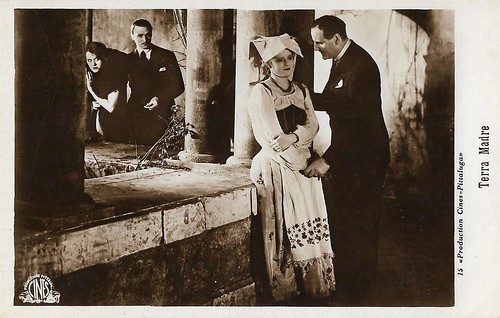
Italian postcard by G.B. Falci, Milano, no. 15. Photo: Cines-Pittaluga, Roma. Postcard for the Italian early sound film Terra madre/Mother Earth (Alessandro Blasetti, 1931), with on the right Leda Gloria as Emilia and Sandro Salvini as Duke Marco. Left in the back, Isa Pola as Daisy and her friend, played by Giorgio Bianchi.
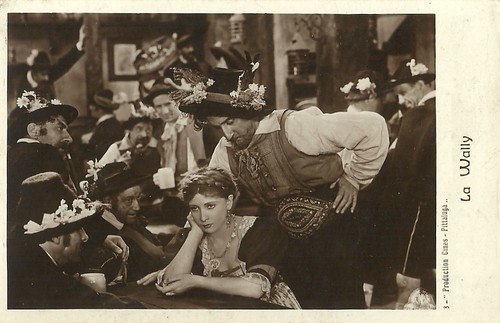
Italian postcard. Photo: Cines-Pittaluga. Carlo Ninchi and Isa Pola in La Wally (Guido Brignone, 1932).
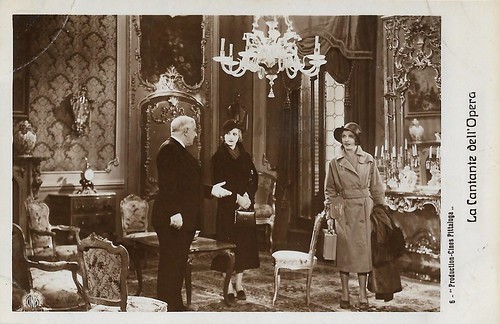
Italian postcard., no. 6. Photo: Cines-Pittaluga. Germana Paolieri and Isa Pola in La cantante dell'opera (Nunzio Malasomma, 1932).
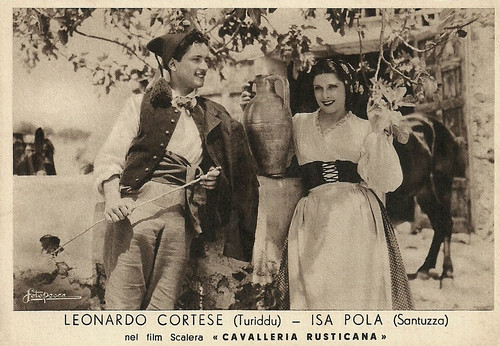
Italian postcard by Scalera, Roma/Zincografia, Firenze. Photo: Pesce. In the drama Cavalleria rusticana (Amleto Palermi, 1939), Isa Pola and Leonardo Cortese had the leads. The film was based on the work of Giovanni Verga, which was also turned into an opera by Pietro Mascagni.
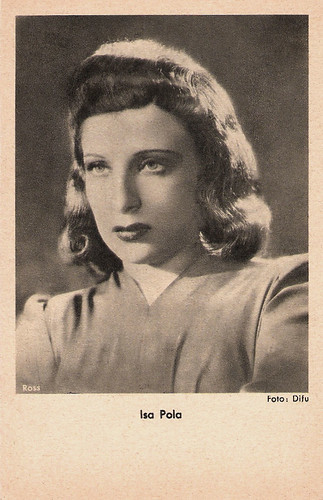
German postcard by Das Programm von Heute, Berlin / Ross. Photo: Difu. Isa Pola in Il ponte di vetro/Bridge of Glass (Goffredo Alessandrini, 1940).
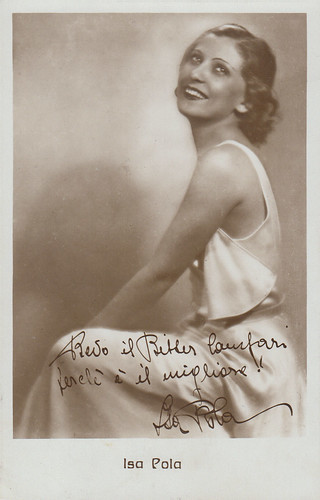
Italian postcard. Collection: Marlene Pilaete.
Perfidious and Adulterous Woman
A highlight in Isa Pola's career was her part of the wife of Emilio Cigoli who betrays her husband with Adriano Rimoldi in Vittorio De Sica ’s realist melodrama I bambini ci guardano/The Children Are Watching Us (1943).
Joel Kanoff at Film Reference : "with I bambini ci guardano, De Sica teamed with Cesare Zavattini, who was to become his major collaborator for the next three decades. Together they began to demonstrate elements of the post-war realist aesthetic which, more than any other director except Visconti and Rossellini, De Sica helped shape and determine.
Despite the overt melodrama of the misogynistic story (a young mother destroys her family by deserting them), the filmmaker refused to narrow the perspective through an overwrought Hollywoodian mise-en-scène, preferring instead a refreshing simplicity of composition and a subdued editing style. Much of the film's original flavor can be traced to the clear, subjective mediation of a child, as promised in the title."
In the postwar era, Isa Pola returned to the cliché of the perfidious and adulterous woman in Furia/Fury (Goffredo Alessandrini, 1947) with Gino Cervi , Ombre sul Canal Grande/Shadows on the Grand Canal (1951, Glauco Pellegrini) with Antonio Centa , and Tre storie proibite/Three Forbidden Stories (1952, Augusto Genina) with Gabriele Ferzetti as the mother of Lia Amanda.
Until the late 1950s, Isa Pola stayed active in cinema, while pursuing a modest career on television on the side in the years 1957-1959. After having started on stage in revues with Nino Besozzi, Antonio Gandusio and Enrico Viarisio, Pola turned towards prose theatre.
Thanks to her clear voice and her perfect mastering of Venetian dialect she excelled on stage with the Compagnia del Teatro Veneto, in particular in 1936 with La vedova (The widow) and in 1947 alongside Cesco Baseggio in Il bugiardo (The Liar).
In addition to comedies by Carlo Goldoni, she also performed in texts by Giacinto Gallina, George Bernard Shaw (Non si sa mai/You Never Can Tell), Alberto Moravia (Gli indifferenti/The indifferent), Torquato Tasso (Intrighi d'amore/Intrigues of love), Gabriele D'Annunzio (La fiaccola sotto il moggio/The light under a bushel) and Luigi Pirandello. She was also striking in comical theatre alongside Alberto Bonucci in 1958.
After having retired, Isa Pola died in 1984 in Milan, at the age of 74.

Italian postcard by Rizzoli, Milano, 1937. Photo: Demanins.
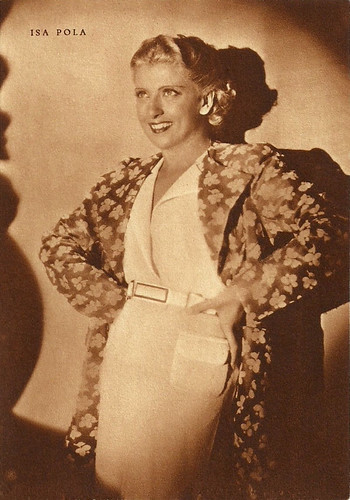
Italian postcard by Rizzoli, Milano, 1938.
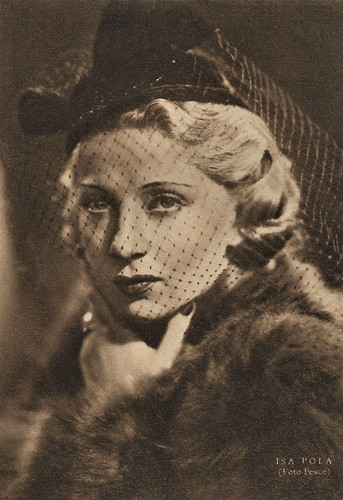
Italian postcard by Rizzoli, Milano, 1939. Photo: Pesce.
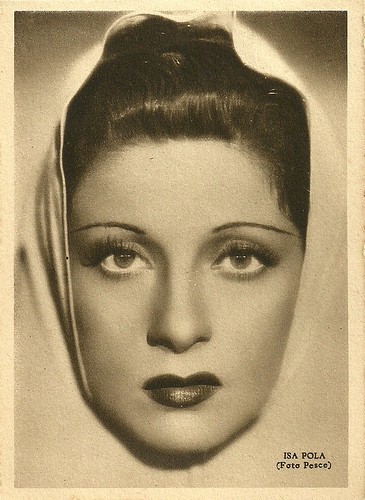
Italian postcard by Rizzoli, Milano, 1940. Photo: Pesce. Portrait for Cavalleria rusticana (Amleto Palermi, 1939).
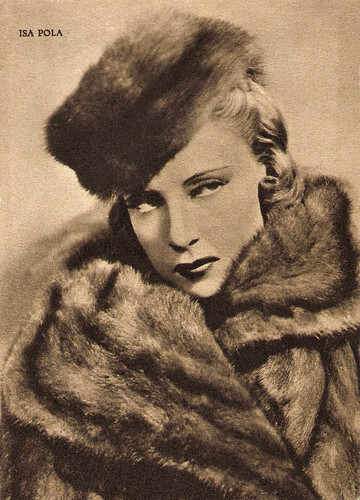
Italian postcard by Rizzoli, Milano, 1941.
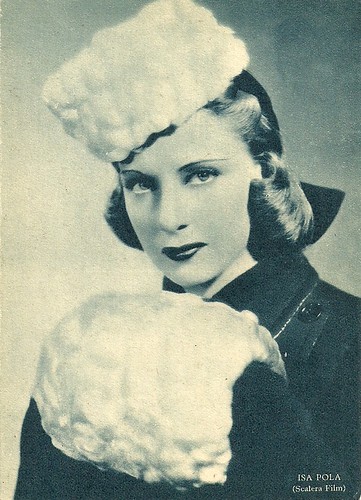
Italian postcard by Rizzoli, Milano, 1942. Photo: Scalera Film.
Sources: Joel Kanoff (Film Reference), CinéArtistes (French), Wikipedia (Italian), and .

Italian postcard in the Cines Pittaluga series by Casa Edit. Ballerini & Fratini, Firenze, no. 2574. Photo: Cines Pittaluga.

Italian postcard by Ed. G.B. Falci, Milano, no. 39. Photo: Cines. Pittaluga, Roma. Isa Pola and Elio Steiner in La canzone dell'amore (Gennaro Righelli, 1930).

Italian postcard. Photo: Pesce / Scalera Film. Isa Pola as Santuzza in Cavalleria rusticana (Amleto Palermi, 1939).

Italian postcard by Hector, no. 2.20, 1941. Photo: Pexce / Scalera Film. Isa Pola in Lucrezia Borgia (Hans Hinrich, 1940).

Italian card by ASER, Rome, no. 240. Photo: Pesce / Scalera Film. Isa Pola in Una signora dell'ovest/Girl of the Golden West (Carl Koch, 1942).
Something Captivating and Almost Perverse
Isa Pola was born Maria Luisa Betti di Montesano in Bologna, Italy in 1909. Isa had a passion for acting and cinema at an early stage, and picked as her stage name Pola. She was beautiful, photogenic, had something captivating and almost perverse.
She made her film debut with a small part in Martiri d'Italia/Martyrs of Italy (Domenico Gaido, 1927). Other small parts followed in which she was type-casted as the evil adventuress. This eventually lead to her first major part in Myriam (Enrico Guazzoni, 1928).
After the introduction of sound film, Pola’s career really took off. She played the antagonist of Dria Paola in the first Italian sound film La canzone dell’amore/The song of love (Gennaro Righelli, 1930). From that film on Pola became a true diva of the Italian sound cinema. With her photogenic qualities, frankness and pleasant voice she broke with the tradition of the languid divas of the silent era.
She continued her success throughout the 1930s with such hit films as Terra madre/Mother Earth (Alessandro Blasetti, 1931) opposite Leda Gloria , La Wally (Guido Brignone, 1931) featuring Germana Paolieri , L'ultima avventura/The Last Adventure (Mario Camerini, 1932), La telefonista/The switchboard Operator (Nunzio Malasomma, 1932), Acciaio/Steel (Walther Ruttmann, 1933) and the comedy L'anonima Roylott/The anonymous Roylott (Raffaello Matarazzo, 1936).
Her part as a serious and streetwise telephone operator in La telefonista contrasted with her previous vamp roles and gave her image a new, interesting twist. Thanks to this versatility, her career quickly marched on. As a popular diva of the Italian screens, she starred together with the big male stars of those years: Fosco Giachetti , Gino Cervi , Rossano Brazzi and Antonio Centa , alternating the type of the perfidious, insatiable woman with the honest and pious wife, and the defenseless girl with the adulterous bourgeois lady. She played Santuzza in Cavalleria rusticana (Amleto Palermi, 1939) opposite Leonardo Cortese as Turiddu, she performed the title role in Lucrezia Borgia (Hans Hinrich, 1940), and did the female lead of Arianna in the now lost Western Una signora dell’ovest/Girl of the Golden West (Carl Koch, 1942) with Michel Simon , Rossano Brazzi and Valentina Cortese .

Italian postcard by G.B. Falci, Milano, no. 15. Photo: Cines-Pittaluga, Roma. Postcard for the Italian early sound film Terra madre/Mother Earth (Alessandro Blasetti, 1931), with on the right Leda Gloria as Emilia and Sandro Salvini as Duke Marco. Left in the back, Isa Pola as Daisy and her friend, played by Giorgio Bianchi.

Italian postcard. Photo: Cines-Pittaluga. Carlo Ninchi and Isa Pola in La Wally (Guido Brignone, 1932).

Italian postcard., no. 6. Photo: Cines-Pittaluga. Germana Paolieri and Isa Pola in La cantante dell'opera (Nunzio Malasomma, 1932).

Italian postcard by Scalera, Roma/Zincografia, Firenze. Photo: Pesce. In the drama Cavalleria rusticana (Amleto Palermi, 1939), Isa Pola and Leonardo Cortese had the leads. The film was based on the work of Giovanni Verga, which was also turned into an opera by Pietro Mascagni.

German postcard by Das Programm von Heute, Berlin / Ross. Photo: Difu. Isa Pola in Il ponte di vetro/Bridge of Glass (Goffredo Alessandrini, 1940).

Italian postcard. Collection: Marlene Pilaete.
Perfidious and Adulterous Woman
A highlight in Isa Pola's career was her part of the wife of Emilio Cigoli who betrays her husband with Adriano Rimoldi in Vittorio De Sica ’s realist melodrama I bambini ci guardano/The Children Are Watching Us (1943).
Joel Kanoff at Film Reference : "with I bambini ci guardano, De Sica teamed with Cesare Zavattini, who was to become his major collaborator for the next three decades. Together they began to demonstrate elements of the post-war realist aesthetic which, more than any other director except Visconti and Rossellini, De Sica helped shape and determine.
Despite the overt melodrama of the misogynistic story (a young mother destroys her family by deserting them), the filmmaker refused to narrow the perspective through an overwrought Hollywoodian mise-en-scène, preferring instead a refreshing simplicity of composition and a subdued editing style. Much of the film's original flavor can be traced to the clear, subjective mediation of a child, as promised in the title."
In the postwar era, Isa Pola returned to the cliché of the perfidious and adulterous woman in Furia/Fury (Goffredo Alessandrini, 1947) with Gino Cervi , Ombre sul Canal Grande/Shadows on the Grand Canal (1951, Glauco Pellegrini) with Antonio Centa , and Tre storie proibite/Three Forbidden Stories (1952, Augusto Genina) with Gabriele Ferzetti as the mother of Lia Amanda.
Until the late 1950s, Isa Pola stayed active in cinema, while pursuing a modest career on television on the side in the years 1957-1959. After having started on stage in revues with Nino Besozzi, Antonio Gandusio and Enrico Viarisio, Pola turned towards prose theatre.
Thanks to her clear voice and her perfect mastering of Venetian dialect she excelled on stage with the Compagnia del Teatro Veneto, in particular in 1936 with La vedova (The widow) and in 1947 alongside Cesco Baseggio in Il bugiardo (The Liar).
In addition to comedies by Carlo Goldoni, she also performed in texts by Giacinto Gallina, George Bernard Shaw (Non si sa mai/You Never Can Tell), Alberto Moravia (Gli indifferenti/The indifferent), Torquato Tasso (Intrighi d'amore/Intrigues of love), Gabriele D'Annunzio (La fiaccola sotto il moggio/The light under a bushel) and Luigi Pirandello. She was also striking in comical theatre alongside Alberto Bonucci in 1958.
After having retired, Isa Pola died in 1984 in Milan, at the age of 74.

Italian postcard by Rizzoli, Milano, 1937. Photo: Demanins.

Italian postcard by Rizzoli, Milano, 1938.

Italian postcard by Rizzoli, Milano, 1939. Photo: Pesce.

Italian postcard by Rizzoli, Milano, 1940. Photo: Pesce. Portrait for Cavalleria rusticana (Amleto Palermi, 1939).

Italian postcard by Rizzoli, Milano, 1941.

Italian postcard by Rizzoli, Milano, 1942. Photo: Scalera Film.
Sources: Joel Kanoff (Film Reference), CinéArtistes (French), Wikipedia (Italian), and .
Published on April 28, 2020 22:00
April 27, 2020
Der Cowboy (1918)
Der Cowboy/The Cowboy (1918) is one of the first German wild west films ever. Star and director was Alwin Neuss, who was known for his portrayal of Sherlock Holmes. He was influenced by such American Western stars as William S. Hart and Tom Mix. The silent film was produced by Erich Pommer for the Decla Studio and was made in the Eiko film studio in Berlin-Marienfelde.
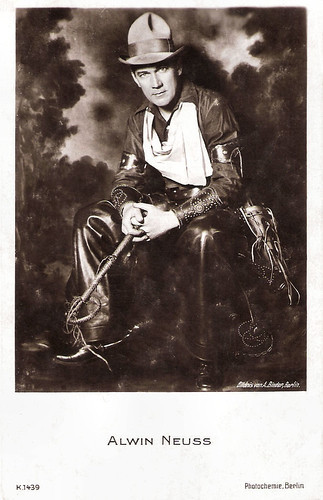
German postcard by Photochemie, Berlin, no. K 1439. Photo: Alex Binder, Berlin.
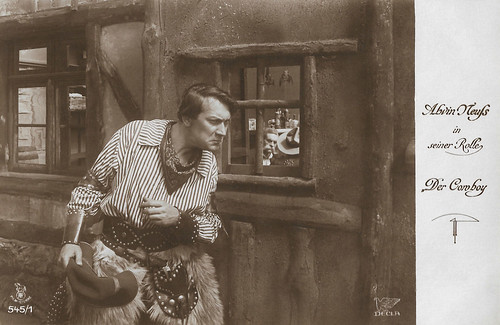
German postcard in the Film-Sterne series by Rotophot, no. 545/1. Photo: Decla. Alwin Neuss in Der Cowboy/The Cowboy (Alwin Neuss, 1918).
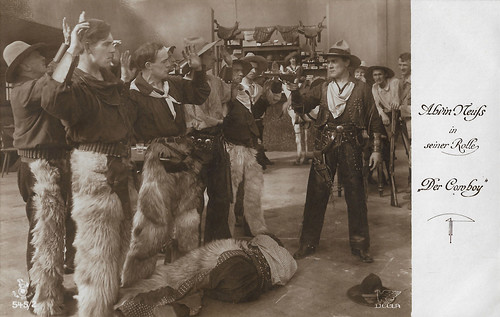
German postcard in the Film-Sterne series by Rotophot, no. 545/2. Photo: Decla. Alwin Neuss in Der Cowboy/The Cowboy (Alwin Neuss, 1918).
A cowboy at the castle
The script of Der Cowboy/The Cowboy (Alwin Neuss, 1918) was written by the Austrian actor and author Max Jungk. German Wikipedia offers the storyline: Fred Hagenow, a German gentleman, runs a large farm on Java. One day he travels to New York City to visit Gerd von Rauenstein ( Alwin Neuss ), the son of an old friend (Max Laurence). He learns from his friend that Gerd recently made an ominous acquaintance with a certain Baroness von Wartenberg, a fraudulent adventurer who has murdered men.
When Gerd, who had been rejected by his father because of this improper acquaintance, caught her 'in flagranti' with a rival, he drew a gun to shoot the competitor. Obviously, he then stopped himself from the murder and then fled to America to make a fresh start there as a cowboy. Fred invites Gerd to follow him to his farm, where he could be useful. That's what happens.
Fred connects behind Gerd's back with old Von Rauenstein's lawyer to find out whether a reconciliation between father and son would be possible. The lawyer asks Fred to send Gerd home as soon as possible since the old man is dying and Gerd von Rauenstein is the only heir. Gerd swings into the saddle and starts to ride to the next port. But a bad guy strikes him out of the ambush. His name is Hollmann (also Alwin Neuss ), he is a cousin of Gerds and he wants to take advantage of the striking resemblance to his cousin in order to enjoy the inheritance himself. Hollmann steals from the wounded Gerd the documents that can prove his identity and leaves.
While Gerd, who has promptly lost his memory due to the grazing shot on the head, is being well cared for on the farm, Hollmann goes to Rauenstein Castle to deceive the old man as a false son and to take over the inheritance. Hollmann quickly swings himself up as the new gentleman on Rauenstein and has also cast an eye on the neighboring landlord's daughter Eulalia, who had previously been adored by Gerd.
Gerd has a fragmentary memory, only suddenly he believes that he is Hollmann and should take over the small inheritance of the windy, villainous cousin, whose mother has passed away. It is only when he has all his senses back together that he realises that Cousin Hollmann has obviously pushed him away to as the legitimate heir of Rauenstein Castle.
Gerd tries to confront the usurper. He comes across Eulalia, who admits that she, too, has long seen through the wrong Gerd alias Hollmann. Both make a plan to expose and get rid of the villain. At a lavish castle festival, Hollmann disguises himself as a cowboy to give truth to his past life. A second man appears in cowboy disguise and with a mask. He unmasks himself and reveals himself as a true Gerd von Rauenstein. Hollmann is unmasked, flees to an adjacent room and shoots himself.
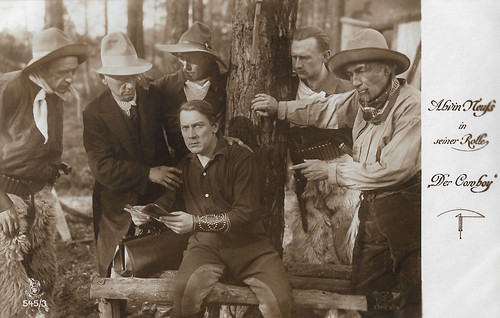
German postcard in the Film-Sterne series by Rotophot, no. 545/3. Photo: Decla. Alwin Neuss in Der Cowboy/The Cowboy (Alwin Neuss, 1918).
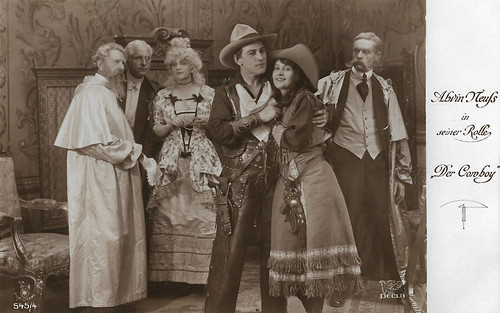
German postcard in the Film-Sterne series by Rotophot, no. 545/4. Photo: Decla. Alwin Neuss in Der Cowboy/The Cowboy (Alwin Neuss, 1918).
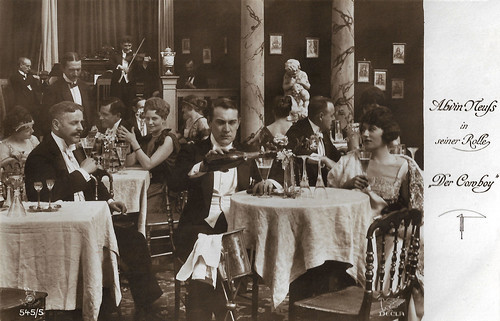
German postcard in the Film-Sterne series by Rotophot, no. 545/5. Photo: Decla. Alwin Neuss in Der Cowboy/The Cowboy (Alwin Neuss, 1918).
Sources: Wikipedia (German) and The German Early Cinema Database.

German postcard by Photochemie, Berlin, no. K 1439. Photo: Alex Binder, Berlin.

German postcard in the Film-Sterne series by Rotophot, no. 545/1. Photo: Decla. Alwin Neuss in Der Cowboy/The Cowboy (Alwin Neuss, 1918).

German postcard in the Film-Sterne series by Rotophot, no. 545/2. Photo: Decla. Alwin Neuss in Der Cowboy/The Cowboy (Alwin Neuss, 1918).
A cowboy at the castle
The script of Der Cowboy/The Cowboy (Alwin Neuss, 1918) was written by the Austrian actor and author Max Jungk. German Wikipedia offers the storyline: Fred Hagenow, a German gentleman, runs a large farm on Java. One day he travels to New York City to visit Gerd von Rauenstein ( Alwin Neuss ), the son of an old friend (Max Laurence). He learns from his friend that Gerd recently made an ominous acquaintance with a certain Baroness von Wartenberg, a fraudulent adventurer who has murdered men.
When Gerd, who had been rejected by his father because of this improper acquaintance, caught her 'in flagranti' with a rival, he drew a gun to shoot the competitor. Obviously, he then stopped himself from the murder and then fled to America to make a fresh start there as a cowboy. Fred invites Gerd to follow him to his farm, where he could be useful. That's what happens.
Fred connects behind Gerd's back with old Von Rauenstein's lawyer to find out whether a reconciliation between father and son would be possible. The lawyer asks Fred to send Gerd home as soon as possible since the old man is dying and Gerd von Rauenstein is the only heir. Gerd swings into the saddle and starts to ride to the next port. But a bad guy strikes him out of the ambush. His name is Hollmann (also Alwin Neuss ), he is a cousin of Gerds and he wants to take advantage of the striking resemblance to his cousin in order to enjoy the inheritance himself. Hollmann steals from the wounded Gerd the documents that can prove his identity and leaves.
While Gerd, who has promptly lost his memory due to the grazing shot on the head, is being well cared for on the farm, Hollmann goes to Rauenstein Castle to deceive the old man as a false son and to take over the inheritance. Hollmann quickly swings himself up as the new gentleman on Rauenstein and has also cast an eye on the neighboring landlord's daughter Eulalia, who had previously been adored by Gerd.
Gerd has a fragmentary memory, only suddenly he believes that he is Hollmann and should take over the small inheritance of the windy, villainous cousin, whose mother has passed away. It is only when he has all his senses back together that he realises that Cousin Hollmann has obviously pushed him away to as the legitimate heir of Rauenstein Castle.
Gerd tries to confront the usurper. He comes across Eulalia, who admits that she, too, has long seen through the wrong Gerd alias Hollmann. Both make a plan to expose and get rid of the villain. At a lavish castle festival, Hollmann disguises himself as a cowboy to give truth to his past life. A second man appears in cowboy disguise and with a mask. He unmasks himself and reveals himself as a true Gerd von Rauenstein. Hollmann is unmasked, flees to an adjacent room and shoots himself.

German postcard in the Film-Sterne series by Rotophot, no. 545/3. Photo: Decla. Alwin Neuss in Der Cowboy/The Cowboy (Alwin Neuss, 1918).

German postcard in the Film-Sterne series by Rotophot, no. 545/4. Photo: Decla. Alwin Neuss in Der Cowboy/The Cowboy (Alwin Neuss, 1918).

German postcard in the Film-Sterne series by Rotophot, no. 545/5. Photo: Decla. Alwin Neuss in Der Cowboy/The Cowboy (Alwin Neuss, 1918).
Sources: Wikipedia (German) and The German Early Cinema Database.
Published on April 27, 2020 22:00
April 26, 2020
Joachim Gottschalk
During the 1930s, German stage and film star Joachim Gottschalk (1904-1941) was a romantic lead in the style of Clark Gable. He starred in a series of films opposite the popular German actress Brigitte Horney. When the Nazis demanded that he would separate from his Jewish wife, the Gottschalks committed suicide.
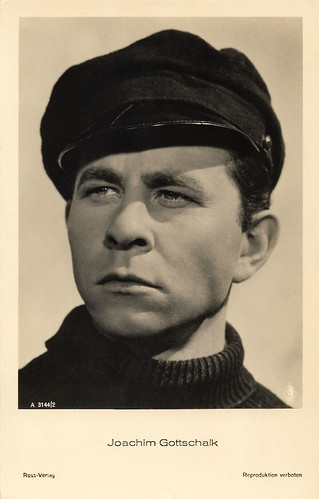
German postcard by Ross-Verlag, no. A 3144/2, 1941-1944. Photo: Bavaria-Filmkunst. Joachim Gottschalk in Das Mädchen von Fanö/The Girl from Fano (Hans Schweikart, 1941).
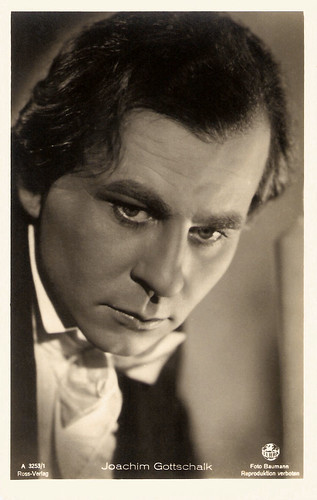
German postcard by Ross-Verlag, no. A 3253/1, 1941-1944. Photo: Baumann / Terra. Joachim Gottschalk in Die schwedische Nachtigall/The Swedish nightingale (Peter Paul Brauer, 1941).
The German Clark Gable
Joachim Gottschalk was born in Calau, Germany, in 1904. He was the son of a doctor. He attended the Gymnasium in Cottbus and after his exams, he went to sea. Between 1922 and 1926 he sailed on the three-master Großherzogin Elisabeth to Chile and to Australia.
After leaving service, he took acting classes in Berlin and Cottbus. During an engagement at the Württembergische Volksbühne in Stuttgart, he met his future wife, the actress Meta Wolff. In May 1930 they married in Halberstadt and in February 1933 their son Michael was born.
A few months later Adolph Hitler came to power. Meta was Jewish and Michael thus half-Jewish, but the Gottschalks managed to avoid the anti-Semitic Nuremberg laws and the rising tide of anti-semitic violence in Nazi Germany because of ‘Joschy’ Gottschalk's immense popularity with the public. His wife had a Berufsverbot but Gottschalk could continue his acting if he stayed secret about his family situation.
After an engagement in Leipzig, Gottschalk played from 1934 to 1938 in Frankfurt am Main. There he had his breakthrough at the Municipal Theater in parts as a hero and romantic lover. In 1938 he moved to Berlin to play at the Volksbühne. There he had a smash hit with his title role in the play 'Fiesco' by Friedrich Schiller. His theatrical successes made him one of the most popular actors in the capital.
In 1938 he also began his film career with a starring role alongside Brigitte Horney in the Tobis production Du und ich/You and I (Wolfgang Liebeneiner, 1938). The film was a success, and the two leads subsequently made four more films together.
In Tripoli in Libya, they filmed Aufruhr in Damaskus/Tumult in Damascus (Gustav Ucicky, 1939). Then they starred in the successful romantic comedy Eine Frau wie du/A Woman Like You (Viktor Tourjansky, 1939) with Hans Brausewetter , which made Gottschalk ‘the German Clark Gable’. On the island Farnö, they next filmed the romantic drama Das Mädchen von Fanö/The Girl from Fano (Hans Schweikart, 1940) with Gustav Knuth.
Gottschalk also appeared with Paula Wessely in the melodrama Ein Leben lang/A whole life long (Gustav Ucicky, 1939), and with Hertha Feiler in Flucht ins Dunkel/Escape into Darkness (Arthur Maria Rabenalt, 1939).
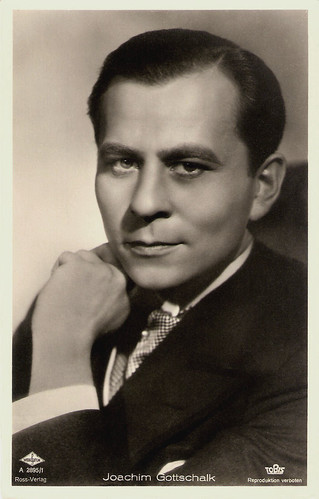
German postcard by Ross-Verlag, no. A 2895/1, 1941-1944. Photo: Wien-Film / Tobis.
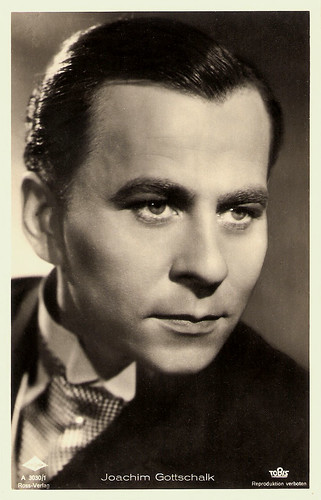
German postcard by Ross-Verlag, no. A 3030/1, 1941-1944. Photo: Wien-Film / Tobis.
No Way Out
After the start of the war, the pressure of the Propaganda Ministry on Joachim Gottschalk began to increase. Hans Hinkel, Special Representative for Kulturpersonalien (cultural celebrities) demanded Gottschalk to divorce, but the star refused.
He worked in the studio on Die schwedische Nachtigall/The Swedish Nightingale (Peter Paul Brauer, 1941) about the romance of fairytale writer Hans Christian Andersen (Gottschalk) and the Danish singer Jenny Lind ( Ilse Werner ). It was again a huge success.
Another triumph was his stage role as Silvio in Carlo Goldoni's 'Servant of Two Masters'. But in early June as Volksbühne director Eugen Klöpfer presented his next production, Faust, Gottschalk's name was not on the cast list. He was not offered any more roles at any Berlin stage.
Wikipedia explains what had caused the ban. Naively, Gottschalk had taken his Jewish wife to a film industry Artist's Association dinner and introduced her to some of the prominent Nazis who were present. Although the Nazis were charmed, when Propaganda Minister Joseph Goebbels learned about this incident, he decreed that Gottschalk would be required to separate from his Jewish wife.
Klaus J. Hennig at DieZeit.de writes that Goebbels was even present at the dinner and was charmed by Gottschalk’s wife, but he became enraged when he later found out that Meta was Jewish. When Gottschalk refused to separate, Goebbels ordered Gottschalk's wife and child transported to the Theresienstadt concentration camp. Gottschalk insisted on accompanying Meta and Michael to Theresienstadt, but Goebbels ordered Gottschalk inducted into the German Army, the Wehrmacht.
The Gottschalks saw no way out. In November 1941, minutes before the expected arrival of the Gestapo at their apartment in Berlin-Grunewald, they first sedated their nine-year-old son and then committed suicide by gas poisoning. Joachim Gottschalk was only 37 when he died.
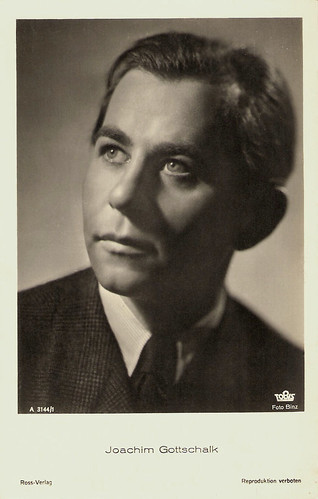
German postcard by Ross-Verlag, no. A 3144/1, 1941-1944. Photo: Binz / Tobis.
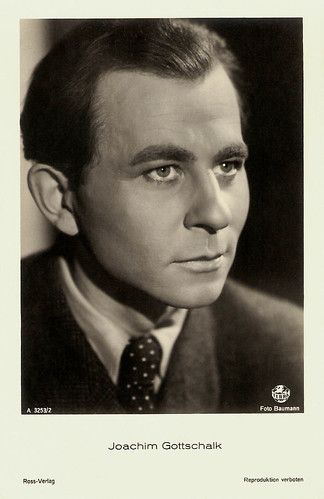
German postcard by Ross-Verlag, no. A 3253/2, 1941-1944. Photo: Baumann / Terra.
Only a Few Courageous Colleagues
Joachim Gottschalk was buried with his wife and son in one grave (it was forbidden to bury Jews and non-Jews together) at the Südwestkirchhof Stahnsdorf of Berlin. Only a few courageous colleagues attended the funeral, among them were Brigitte Horney , Gustav Knuth, Hans Brausewetter , Werner Hinz, Wolfgang Liebeneiner and Ruth Hellberg .
Joseph Goebbels forbade any obituary, but word about his death got out anyway and millions of German women were in mourning. Because of Nazi censorship, most of his devoted fans did not learn the awful circumstances of his death.
This incident poisoned the already-tense relationship between Goebbels and the German film community. At the end of WWII, Goebbels and his wife would also commit suicide in Hitler's Berlin bunker and poisoned their six young children. Goebbels' motive was fear of being captured by the advancing Soviet Army, which was less than a mile away. Goebbels had played a major role in the Holocaust, including the production of a series of anti-Semitic films, and he knew he would have been put on trial and executed, had he lived.
After the war, the DEFA studio made a film about Joachim Gottschalk, Ehe im Schatten/Marriage in the Shadows (Kurt Maetzig, 1949). Finally, the tragic fate of Gottschalk and his family became known to the German public. The film was based on the novella Es wird schon nicht so schlimm (It won’t become that bad), written by Gottschalk’s former director Hans Schweikart.
Since 1999, Joachim Gottschalk’s grave is an Ehrengrab (grave of honour) for the city of Berlin.
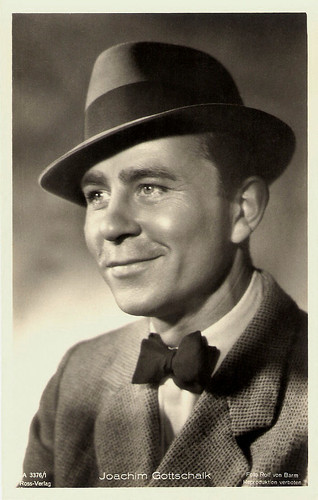
German postcard by Ross-Verlag, no. A 3376/1, 1941-1944. Photo: Rolf von Barm.

Silhouette in memory of Jews deported from the Grünewald Station in Berlin. Grünewald was the area, where Gottschalk and his family lived. This deportation memorial was erected fifty years after the beginning of deportations of Berlin's Jewish population to concentration camps. The Polish artist Karol Broniatowski created this concrete block embedded with human silhouettes representative of the passage taken to the rail tracks for deportation in 1991. Between October 1941 and February 1943 more than 50,000 Jews of Berlin were deported by the National Socialist state from Grünewald Station.
Sources: Klaus J. Hennig (Die Zeit), Hanns-Georg Rodek (Filmportal.de - German), Wikipedia (German and English), and .

German postcard by Ross-Verlag, no. A 3144/2, 1941-1944. Photo: Bavaria-Filmkunst. Joachim Gottschalk in Das Mädchen von Fanö/The Girl from Fano (Hans Schweikart, 1941).

German postcard by Ross-Verlag, no. A 3253/1, 1941-1944. Photo: Baumann / Terra. Joachim Gottschalk in Die schwedische Nachtigall/The Swedish nightingale (Peter Paul Brauer, 1941).
The German Clark Gable
Joachim Gottschalk was born in Calau, Germany, in 1904. He was the son of a doctor. He attended the Gymnasium in Cottbus and after his exams, he went to sea. Between 1922 and 1926 he sailed on the three-master Großherzogin Elisabeth to Chile and to Australia.
After leaving service, he took acting classes in Berlin and Cottbus. During an engagement at the Württembergische Volksbühne in Stuttgart, he met his future wife, the actress Meta Wolff. In May 1930 they married in Halberstadt and in February 1933 their son Michael was born.
A few months later Adolph Hitler came to power. Meta was Jewish and Michael thus half-Jewish, but the Gottschalks managed to avoid the anti-Semitic Nuremberg laws and the rising tide of anti-semitic violence in Nazi Germany because of ‘Joschy’ Gottschalk's immense popularity with the public. His wife had a Berufsverbot but Gottschalk could continue his acting if he stayed secret about his family situation.
After an engagement in Leipzig, Gottschalk played from 1934 to 1938 in Frankfurt am Main. There he had his breakthrough at the Municipal Theater in parts as a hero and romantic lover. In 1938 he moved to Berlin to play at the Volksbühne. There he had a smash hit with his title role in the play 'Fiesco' by Friedrich Schiller. His theatrical successes made him one of the most popular actors in the capital.
In 1938 he also began his film career with a starring role alongside Brigitte Horney in the Tobis production Du und ich/You and I (Wolfgang Liebeneiner, 1938). The film was a success, and the two leads subsequently made four more films together.
In Tripoli in Libya, they filmed Aufruhr in Damaskus/Tumult in Damascus (Gustav Ucicky, 1939). Then they starred in the successful romantic comedy Eine Frau wie du/A Woman Like You (Viktor Tourjansky, 1939) with Hans Brausewetter , which made Gottschalk ‘the German Clark Gable’. On the island Farnö, they next filmed the romantic drama Das Mädchen von Fanö/The Girl from Fano (Hans Schweikart, 1940) with Gustav Knuth.
Gottschalk also appeared with Paula Wessely in the melodrama Ein Leben lang/A whole life long (Gustav Ucicky, 1939), and with Hertha Feiler in Flucht ins Dunkel/Escape into Darkness (Arthur Maria Rabenalt, 1939).

German postcard by Ross-Verlag, no. A 2895/1, 1941-1944. Photo: Wien-Film / Tobis.

German postcard by Ross-Verlag, no. A 3030/1, 1941-1944. Photo: Wien-Film / Tobis.
No Way Out
After the start of the war, the pressure of the Propaganda Ministry on Joachim Gottschalk began to increase. Hans Hinkel, Special Representative for Kulturpersonalien (cultural celebrities) demanded Gottschalk to divorce, but the star refused.
He worked in the studio on Die schwedische Nachtigall/The Swedish Nightingale (Peter Paul Brauer, 1941) about the romance of fairytale writer Hans Christian Andersen (Gottschalk) and the Danish singer Jenny Lind ( Ilse Werner ). It was again a huge success.
Another triumph was his stage role as Silvio in Carlo Goldoni's 'Servant of Two Masters'. But in early June as Volksbühne director Eugen Klöpfer presented his next production, Faust, Gottschalk's name was not on the cast list. He was not offered any more roles at any Berlin stage.
Wikipedia explains what had caused the ban. Naively, Gottschalk had taken his Jewish wife to a film industry Artist's Association dinner and introduced her to some of the prominent Nazis who were present. Although the Nazis were charmed, when Propaganda Minister Joseph Goebbels learned about this incident, he decreed that Gottschalk would be required to separate from his Jewish wife.
Klaus J. Hennig at DieZeit.de writes that Goebbels was even present at the dinner and was charmed by Gottschalk’s wife, but he became enraged when he later found out that Meta was Jewish. When Gottschalk refused to separate, Goebbels ordered Gottschalk's wife and child transported to the Theresienstadt concentration camp. Gottschalk insisted on accompanying Meta and Michael to Theresienstadt, but Goebbels ordered Gottschalk inducted into the German Army, the Wehrmacht.
The Gottschalks saw no way out. In November 1941, minutes before the expected arrival of the Gestapo at their apartment in Berlin-Grunewald, they first sedated their nine-year-old son and then committed suicide by gas poisoning. Joachim Gottschalk was only 37 when he died.

German postcard by Ross-Verlag, no. A 3144/1, 1941-1944. Photo: Binz / Tobis.

German postcard by Ross-Verlag, no. A 3253/2, 1941-1944. Photo: Baumann / Terra.
Only a Few Courageous Colleagues
Joachim Gottschalk was buried with his wife and son in one grave (it was forbidden to bury Jews and non-Jews together) at the Südwestkirchhof Stahnsdorf of Berlin. Only a few courageous colleagues attended the funeral, among them were Brigitte Horney , Gustav Knuth, Hans Brausewetter , Werner Hinz, Wolfgang Liebeneiner and Ruth Hellberg .
Joseph Goebbels forbade any obituary, but word about his death got out anyway and millions of German women were in mourning. Because of Nazi censorship, most of his devoted fans did not learn the awful circumstances of his death.
This incident poisoned the already-tense relationship between Goebbels and the German film community. At the end of WWII, Goebbels and his wife would also commit suicide in Hitler's Berlin bunker and poisoned their six young children. Goebbels' motive was fear of being captured by the advancing Soviet Army, which was less than a mile away. Goebbels had played a major role in the Holocaust, including the production of a series of anti-Semitic films, and he knew he would have been put on trial and executed, had he lived.
After the war, the DEFA studio made a film about Joachim Gottschalk, Ehe im Schatten/Marriage in the Shadows (Kurt Maetzig, 1949). Finally, the tragic fate of Gottschalk and his family became known to the German public. The film was based on the novella Es wird schon nicht so schlimm (It won’t become that bad), written by Gottschalk’s former director Hans Schweikart.
Since 1999, Joachim Gottschalk’s grave is an Ehrengrab (grave of honour) for the city of Berlin.

German postcard by Ross-Verlag, no. A 3376/1, 1941-1944. Photo: Rolf von Barm.

Silhouette in memory of Jews deported from the Grünewald Station in Berlin. Grünewald was the area, where Gottschalk and his family lived. This deportation memorial was erected fifty years after the beginning of deportations of Berlin's Jewish population to concentration camps. The Polish artist Karol Broniatowski created this concrete block embedded with human silhouettes representative of the passage taken to the rail tracks for deportation in 1991. Between October 1941 and February 1943 more than 50,000 Jews of Berlin were deported by the National Socialist state from Grünewald Station.
Sources: Klaus J. Hennig (Die Zeit), Hanns-Georg Rodek (Filmportal.de - German), Wikipedia (German and English), and .
Published on April 26, 2020 22:00
April 25, 2020
Myrna Loy
Myrna Loy (1905-1993) was an American film, television and stage actress. She was originally typecast in exotic roles, often as a vamp or a woman of Asian descent, but her career prospects improved greatly following her portrayal of Nora Charles in The Thin Man (W.S. Van Dyke, 1934). Suddenly she was 'Queen of the Movies' and remained so until the late 1940s.
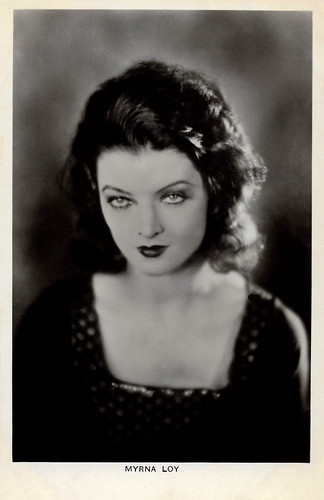
British postcard in the Picturegoer Series, London, no. 355a.
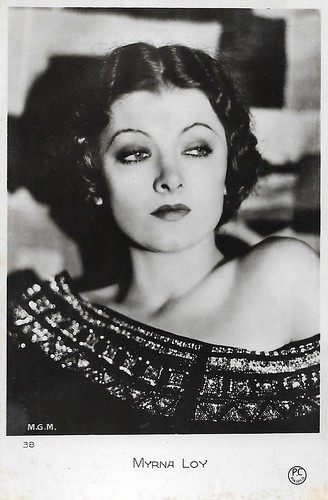
French postcard by P.C., Paris, no. 38. Photo: George Hurrell, c. 1932 / MGM.
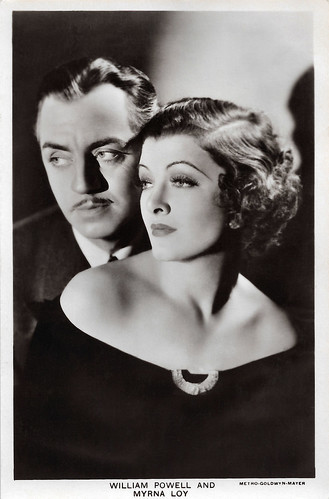
British postcard in the Film Partners Series, London, no. P 161. Photo: Metro-Goldwyn-Mayer. William Powell and Myrna Loy in Evelyn Prentice (William K. Howard, 1934).
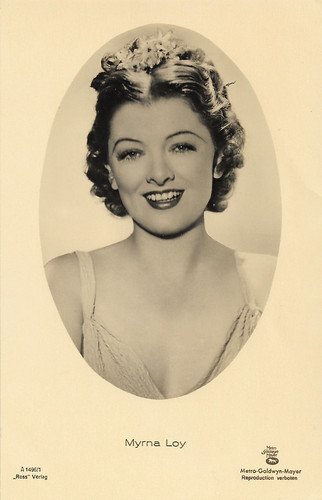
German postcard by Ross Verlag, no. A 1496/1, 1937-1938. Photo: Metro-Goldwyn-Mayer.

French postcard by Editions P.I., Paris, no. 234, presented by Victoria, Brussels, no. 639. Photo: Metro Goldwyn Mayer (M.G.M.), 1950.
Portraying Vamps
Myrna Loy was born Myrna Adele Williams in 1905 in Helena, Montana. Her parents were Adelle Mae (Johnson) and David Franklin Williams.
Loy was raised in rural Radersburg during her early childhood. Her mother was a talented pianist who encouraged Myrna's interest in the arts. When she was thirteen, Myrna's father died of influenza in the Spanish Flu epidemic, and the rest of the family moved to Los Angeles.
There, she began studying dance and trained extensively throughout her high school education. At the age of 15, she appeared in local stage productions in order to help support her family.
She appeared in staged prologues before the films in the famous Grauman's Egyptian Theater in Hollywood. During this period, Loy saw Eleonora Duse in the play 'Thy Will Be Done', and the simple acting techniques she employed made such an impact on Loy that she tried to emulate them throughout her career.
Portrait photographer Henry Waxman took several pictures of her that were noticed by Rudolph Valentino when the actor went to Waxman's studio for a sitting. Valentino was looking for a leading lady for Cobra, the first independent project he and his wife Natacha Rambova were producing. Loy tested for the role, which went to Gertrude Olmstead instead.
Rambova hired Loy for a small but showy role opposite Nita Naldi in What Price Beauty? (Tom Buckingham, 1925-1928), a film she was producing. Shot in May 1925, the film remained unreleased for three years; but stills of Loy in her exotic makeup and costume appeared in Motion Picture magazine and led to a contract with Warner Bros. There, her surname was changed from Williams to Loy.
At Warner Bros., she began obtaining small roles, mainly portraying vamps or femmes fatales. She appeared along with Zasu Pitts and Joan Crawford in Pretty Ladies (Monta Bell, 1925). She also frequently portrayed characters of Asian or Eurasian background in films such as Across the Pacific (Roy Del Ruth, 1926) starring Monte Blue.
Finally, in 1927, she received star billing in Bitter Apples (Harry O'Hoyt, 1927). The excitement was short-lived as she returned to the usual smaller roles afterward. When her contract ran out with Warner, she signed with MGM where she got better roles.
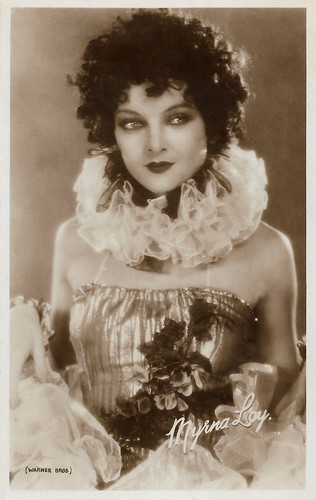
British Real Photograph postcard by Sarony, no. 40. Photo: Warner Bros. Caption: No. 40 of a second Series of 42 CINEMA STARS issued with Sarony Cigarettes.
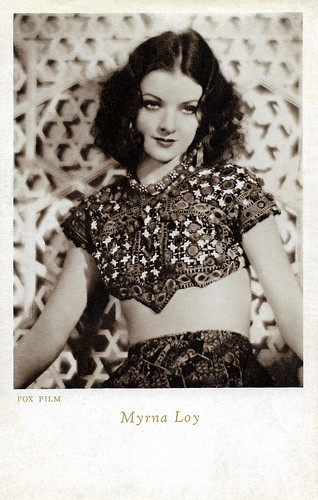
Italian postcard by Cinema-Illustrazione, Milano, no. 7, Serie I. Photo: Fox Film.
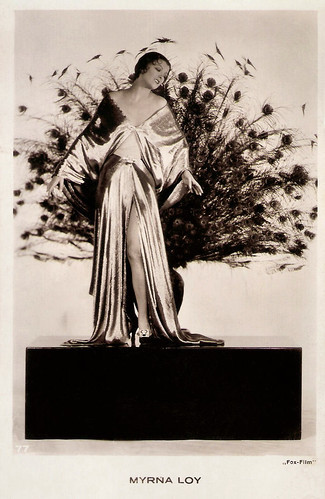
Dutch postcard. Photo: Max Munn Autrey / Fox-Film.
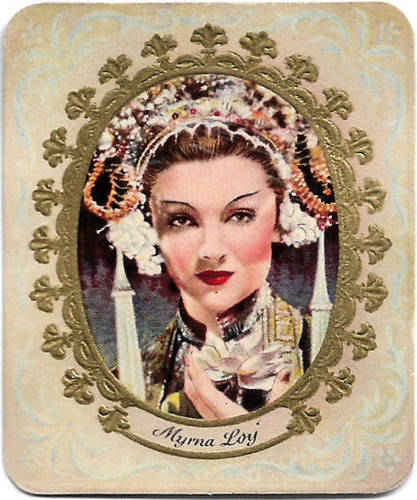
German collectors card in the Moderne Schönheitsgalerie series, no 149 (out of 300). The series was produced by Ross Verlag for Kurmark as a supplement for their Edelzigarette. Photo: Metro Goldwyn Mayer (M.G.M.). Myrna Loy in The Mask of Fu Manchu (Charles Brabin, 1932). She played the depraved sadistic daughter of the title character, played by Boris Karloff .
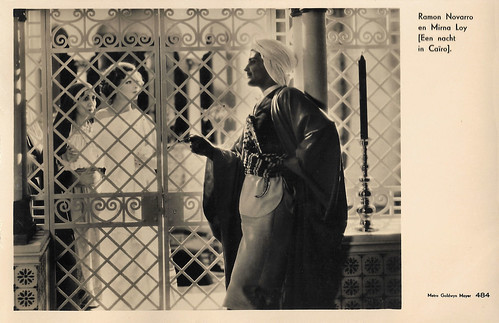
Dutch postcard, no. 484. Photo: Metro-Goldwyn-Mayer. Ramon Novarro and Myrna Loy in The Barbarian (Sam Wood, 1933).
Queen of the Movies
Myrna Loy's role in The Thin Man (W.S. Van Dyke, 1934) with William Powell helped elevate her reputation as a versatile actress. Director W. S. Van Dyke chose Loy after he detected a wit and sense of humour that her previous films had not revealed. At a Hollywood party, he pushed her into a swimming pool to test her reaction and felt that her aplomb in handling the situation was exactly what he envisioned for Nora. Her witty perception of situations gave Loy the image that one could not pull a fast one over on the no-nonsense Mrs. Charles.
The Thin Man became one of the year's biggest hits and was nominated for the Academy Award for Best Picture. From then on, Myrna was a big box-office draw. She was popular enough that, in 1936, she was named 'Queen of the Movies' and Clark Gable the king in a nationwide poll of filmgoers. She reprised the role of Nora Charles five more times. William Powell and she proved to be a popular screen couple and appeared in 14 films together, one of the most prolific pairings in Hollywood history.
Such films as Wife vs. Secretary (Clarence Brown, 1936) with Clark Gable and Jean Harlow , and Petticoat Fever (George Fitzmaurice, 1936) with Robert Montgomery gave her the opportunity to develop her comedic skills. She appeared in two Best Picture Academy Award winners: The Great Ziegfeld (Robert Z. Leonard, 1936) and The Best Years of Our Lives (William Wyler, 1946).
With the outbreak of World War II, Loy focused on the war effort and began devoting her time working with the Red Cross. Earlier, she was so fiercely outspoken against Adolf Hitler that her name appeared on his blacklist, resulting in her films being banned in Germany.
After the war, Myrna Loy was paired with Cary Grant in David O. Selznick's The Bachelor and the Bobby-Soxer (Irving Reis, 1947), co-starring a teenaged Shirley Temple. Following its success, she appeared again with Grant in Mr. Blandings Builds His Dream House (H.C. Potter, 1948). Loy's career began to slow in the late 1940s.
She appeared in only a few films in the 1950s, including a lead role in the comedy Cheaper by the Dozen (Walter Lang, 1950) opposite Clifton Webb, as well as supporting parts in The Ambassador's Daughter (Norman Krasna, 1956) and the drama Lonelyhearts (Vincent J. Donehue, 1958), starring Montgomery Clift.
Later in her career, she was often cast as maternal, heroic characters. In 1973, she made her Broadway debut in a revival of Clare Boothe Luce's 'The Women'. Between 1960 and 1981, she appeared in only eight films, after which she retired from acting. Her last acting role was a guest spot on the sitcom Love, Sidney, in 1982. Her autobiography, 'Myrna Loy: Being and Becoming', was published in 1987.
Although Loy was never nominated for an Academy Award, in March 1991 she received an Honorary Academy Award in recognition of her life's work both onscreen and off, including serving as assistant to the director of the military and naval welfare for the Red Cross during World War II, and a member-at-large of the U.S. Commission to UNESCO.
Myrna Loy died in 1993 in New York City, aged 88. She married and divorced four times. Her husbands were Arthur Hornblow Jr. (1936-1942), John Daniel Hertz Jr. (1942-1944), Gene Markey (1946-1950), and Howland Hill Sargeant (1951-1960).
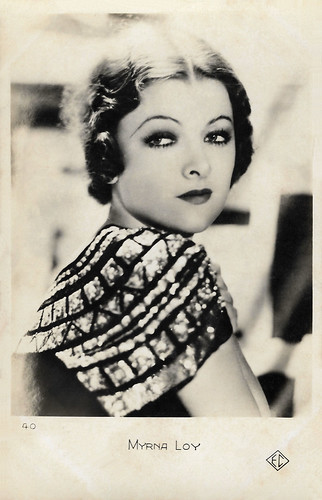
French postcard by Editions Chantal (EC), no. 40. Photo: George Hurrell / Metro-Goldwyn-Mayer, 1932.
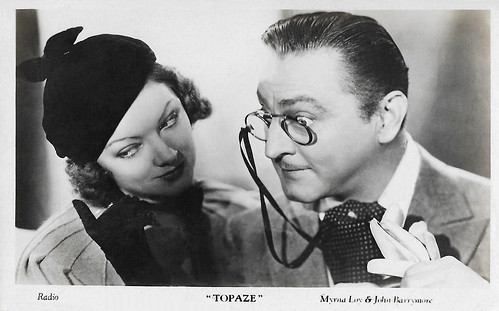
British postcard by Film Weekly. Myrna Loy and John Barrymore in Topaze (Harry D'Abbadie D'Arrast, RKO 1933).
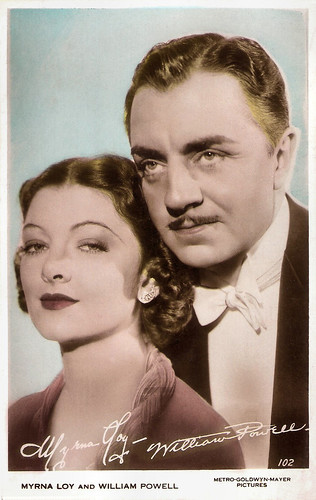
British postcard by Art Photo, no. 102. Photo: Metro-Goldwyn-Mayer. Myrna Loy and Wiliam Powell.
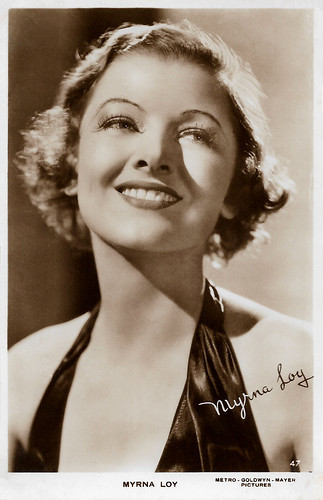
British Real Photograph postcard by Milton, no. 47. Photo: Metro-Goldwyn-Mayer Pictures.
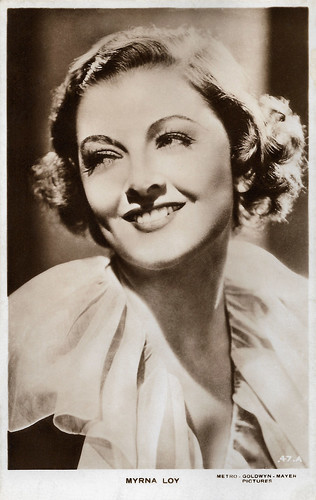
British Real Photograph postcard, no. 47. A. Photo: Metro-Goldwyn-Mayer Pictures.
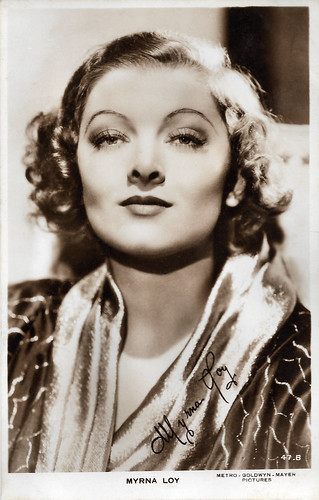
British Real Photograph postcard, no. 47. B. Photo: Metro-Goldwyn-Mayer Pictures.
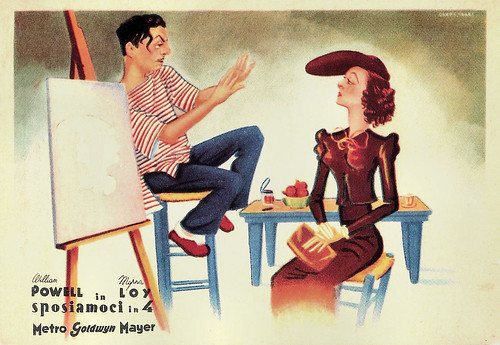
Italian postcard. Art work: Giacomo Canestrari / Metro-Goldwyn-Mayer. William Powell and Myrna Loy in Double Wedding (1937).
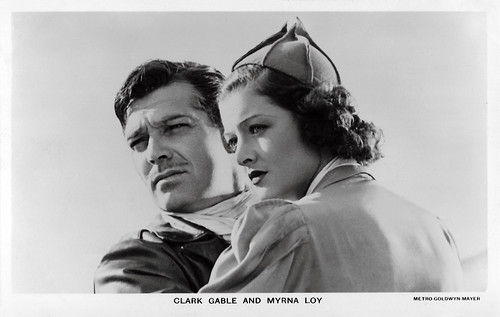
British postcard in the Film Partners Series, London, no. P 249. Photo: Metro-Goldwyn-Mayer. Clark Gable and Myrna Loy in Test Pilot (Victor Fleming, 1938).
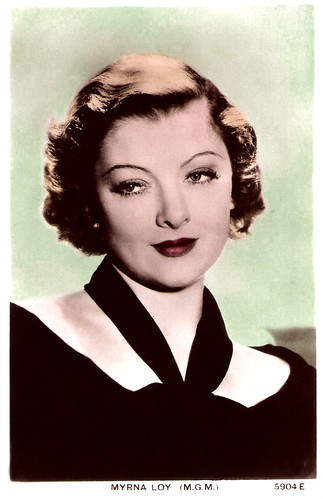
British postcard by Valentine's, no. 5904 E. Photo: M.G.M.
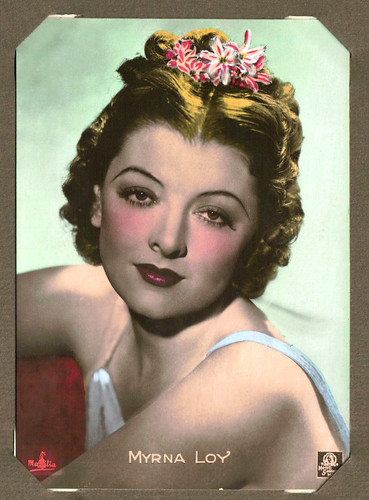
French card by Massilia. Photo: Metro-Goldwyn-Mayer. Collection: Amit Benyovits.
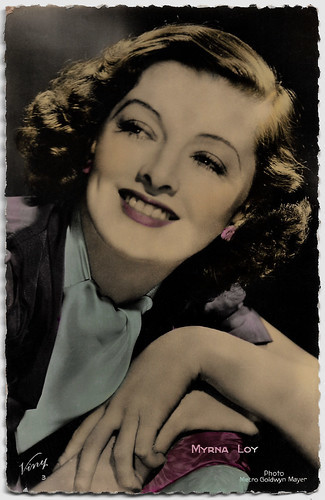
French postcard by Viny, no. 3. Photo: Metro-Goldwyn-Mayer.
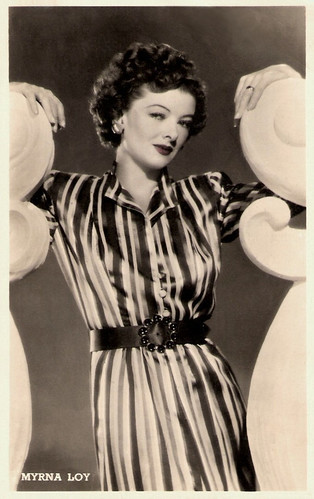
Dutch postcard by J.S.A. (J. Sleding, Amsterdam). Photo: Universal / M.P.E.
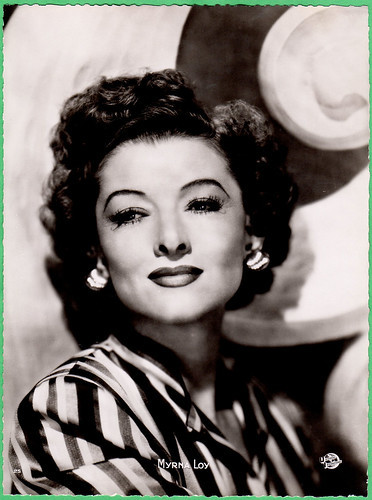
Belgian collectors card by Chocolaterie Clovis, Pepinster, no. 25. Photo: Universal-International. Collection: Amit Benyovits.
Sources: (IMDb), Wikipedia and .

British postcard in the Picturegoer Series, London, no. 355a.

French postcard by P.C., Paris, no. 38. Photo: George Hurrell, c. 1932 / MGM.

British postcard in the Film Partners Series, London, no. P 161. Photo: Metro-Goldwyn-Mayer. William Powell and Myrna Loy in Evelyn Prentice (William K. Howard, 1934).

German postcard by Ross Verlag, no. A 1496/1, 1937-1938. Photo: Metro-Goldwyn-Mayer.

French postcard by Editions P.I., Paris, no. 234, presented by Victoria, Brussels, no. 639. Photo: Metro Goldwyn Mayer (M.G.M.), 1950.
Portraying Vamps
Myrna Loy was born Myrna Adele Williams in 1905 in Helena, Montana. Her parents were Adelle Mae (Johnson) and David Franklin Williams.
Loy was raised in rural Radersburg during her early childhood. Her mother was a talented pianist who encouraged Myrna's interest in the arts. When she was thirteen, Myrna's father died of influenza in the Spanish Flu epidemic, and the rest of the family moved to Los Angeles.
There, she began studying dance and trained extensively throughout her high school education. At the age of 15, she appeared in local stage productions in order to help support her family.
She appeared in staged prologues before the films in the famous Grauman's Egyptian Theater in Hollywood. During this period, Loy saw Eleonora Duse in the play 'Thy Will Be Done', and the simple acting techniques she employed made such an impact on Loy that she tried to emulate them throughout her career.
Portrait photographer Henry Waxman took several pictures of her that were noticed by Rudolph Valentino when the actor went to Waxman's studio for a sitting. Valentino was looking for a leading lady for Cobra, the first independent project he and his wife Natacha Rambova were producing. Loy tested for the role, which went to Gertrude Olmstead instead.
Rambova hired Loy for a small but showy role opposite Nita Naldi in What Price Beauty? (Tom Buckingham, 1925-1928), a film she was producing. Shot in May 1925, the film remained unreleased for three years; but stills of Loy in her exotic makeup and costume appeared in Motion Picture magazine and led to a contract with Warner Bros. There, her surname was changed from Williams to Loy.
At Warner Bros., she began obtaining small roles, mainly portraying vamps or femmes fatales. She appeared along with Zasu Pitts and Joan Crawford in Pretty Ladies (Monta Bell, 1925). She also frequently portrayed characters of Asian or Eurasian background in films such as Across the Pacific (Roy Del Ruth, 1926) starring Monte Blue.
Finally, in 1927, she received star billing in Bitter Apples (Harry O'Hoyt, 1927). The excitement was short-lived as she returned to the usual smaller roles afterward. When her contract ran out with Warner, she signed with MGM where she got better roles.

British Real Photograph postcard by Sarony, no. 40. Photo: Warner Bros. Caption: No. 40 of a second Series of 42 CINEMA STARS issued with Sarony Cigarettes.

Italian postcard by Cinema-Illustrazione, Milano, no. 7, Serie I. Photo: Fox Film.

Dutch postcard. Photo: Max Munn Autrey / Fox-Film.

German collectors card in the Moderne Schönheitsgalerie series, no 149 (out of 300). The series was produced by Ross Verlag for Kurmark as a supplement for their Edelzigarette. Photo: Metro Goldwyn Mayer (M.G.M.). Myrna Loy in The Mask of Fu Manchu (Charles Brabin, 1932). She played the depraved sadistic daughter of the title character, played by Boris Karloff .

Dutch postcard, no. 484. Photo: Metro-Goldwyn-Mayer. Ramon Novarro and Myrna Loy in The Barbarian (Sam Wood, 1933).
Queen of the Movies
Myrna Loy's role in The Thin Man (W.S. Van Dyke, 1934) with William Powell helped elevate her reputation as a versatile actress. Director W. S. Van Dyke chose Loy after he detected a wit and sense of humour that her previous films had not revealed. At a Hollywood party, he pushed her into a swimming pool to test her reaction and felt that her aplomb in handling the situation was exactly what he envisioned for Nora. Her witty perception of situations gave Loy the image that one could not pull a fast one over on the no-nonsense Mrs. Charles.
The Thin Man became one of the year's biggest hits and was nominated for the Academy Award for Best Picture. From then on, Myrna was a big box-office draw. She was popular enough that, in 1936, she was named 'Queen of the Movies' and Clark Gable the king in a nationwide poll of filmgoers. She reprised the role of Nora Charles five more times. William Powell and she proved to be a popular screen couple and appeared in 14 films together, one of the most prolific pairings in Hollywood history.
Such films as Wife vs. Secretary (Clarence Brown, 1936) with Clark Gable and Jean Harlow , and Petticoat Fever (George Fitzmaurice, 1936) with Robert Montgomery gave her the opportunity to develop her comedic skills. She appeared in two Best Picture Academy Award winners: The Great Ziegfeld (Robert Z. Leonard, 1936) and The Best Years of Our Lives (William Wyler, 1946).
With the outbreak of World War II, Loy focused on the war effort and began devoting her time working with the Red Cross. Earlier, she was so fiercely outspoken against Adolf Hitler that her name appeared on his blacklist, resulting in her films being banned in Germany.
After the war, Myrna Loy was paired with Cary Grant in David O. Selznick's The Bachelor and the Bobby-Soxer (Irving Reis, 1947), co-starring a teenaged Shirley Temple. Following its success, she appeared again with Grant in Mr. Blandings Builds His Dream House (H.C. Potter, 1948). Loy's career began to slow in the late 1940s.
She appeared in only a few films in the 1950s, including a lead role in the comedy Cheaper by the Dozen (Walter Lang, 1950) opposite Clifton Webb, as well as supporting parts in The Ambassador's Daughter (Norman Krasna, 1956) and the drama Lonelyhearts (Vincent J. Donehue, 1958), starring Montgomery Clift.
Later in her career, she was often cast as maternal, heroic characters. In 1973, she made her Broadway debut in a revival of Clare Boothe Luce's 'The Women'. Between 1960 and 1981, she appeared in only eight films, after which she retired from acting. Her last acting role was a guest spot on the sitcom Love, Sidney, in 1982. Her autobiography, 'Myrna Loy: Being and Becoming', was published in 1987.
Although Loy was never nominated for an Academy Award, in March 1991 she received an Honorary Academy Award in recognition of her life's work both onscreen and off, including serving as assistant to the director of the military and naval welfare for the Red Cross during World War II, and a member-at-large of the U.S. Commission to UNESCO.
Myrna Loy died in 1993 in New York City, aged 88. She married and divorced four times. Her husbands were Arthur Hornblow Jr. (1936-1942), John Daniel Hertz Jr. (1942-1944), Gene Markey (1946-1950), and Howland Hill Sargeant (1951-1960).

French postcard by Editions Chantal (EC), no. 40. Photo: George Hurrell / Metro-Goldwyn-Mayer, 1932.

British postcard by Film Weekly. Myrna Loy and John Barrymore in Topaze (Harry D'Abbadie D'Arrast, RKO 1933).

British postcard by Art Photo, no. 102. Photo: Metro-Goldwyn-Mayer. Myrna Loy and Wiliam Powell.

British Real Photograph postcard by Milton, no. 47. Photo: Metro-Goldwyn-Mayer Pictures.

British Real Photograph postcard, no. 47. A. Photo: Metro-Goldwyn-Mayer Pictures.

British Real Photograph postcard, no. 47. B. Photo: Metro-Goldwyn-Mayer Pictures.

Italian postcard. Art work: Giacomo Canestrari / Metro-Goldwyn-Mayer. William Powell and Myrna Loy in Double Wedding (1937).

British postcard in the Film Partners Series, London, no. P 249. Photo: Metro-Goldwyn-Mayer. Clark Gable and Myrna Loy in Test Pilot (Victor Fleming, 1938).

British postcard by Valentine's, no. 5904 E. Photo: M.G.M.

French card by Massilia. Photo: Metro-Goldwyn-Mayer. Collection: Amit Benyovits.

French postcard by Viny, no. 3. Photo: Metro-Goldwyn-Mayer.

Dutch postcard by J.S.A. (J. Sleding, Amsterdam). Photo: Universal / M.P.E.

Belgian collectors card by Chocolaterie Clovis, Pepinster, no. 25. Photo: Universal-International. Collection: Amit Benyovits.
Sources: (IMDb), Wikipedia and .
Published on April 25, 2020 22:00
Paul van Yperen's Blog
- Paul van Yperen's profile
- 13 followers
Paul van Yperen isn't a Goodreads Author
(yet),
but they
do have a blog,
so here are some recent posts imported from
their feed.



